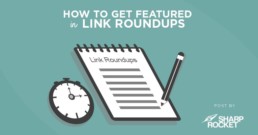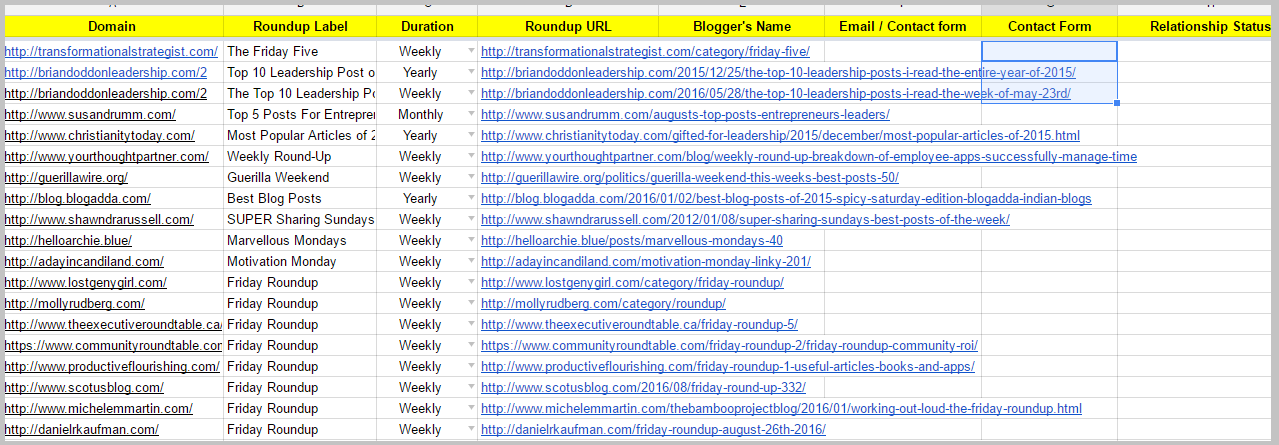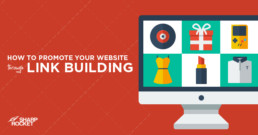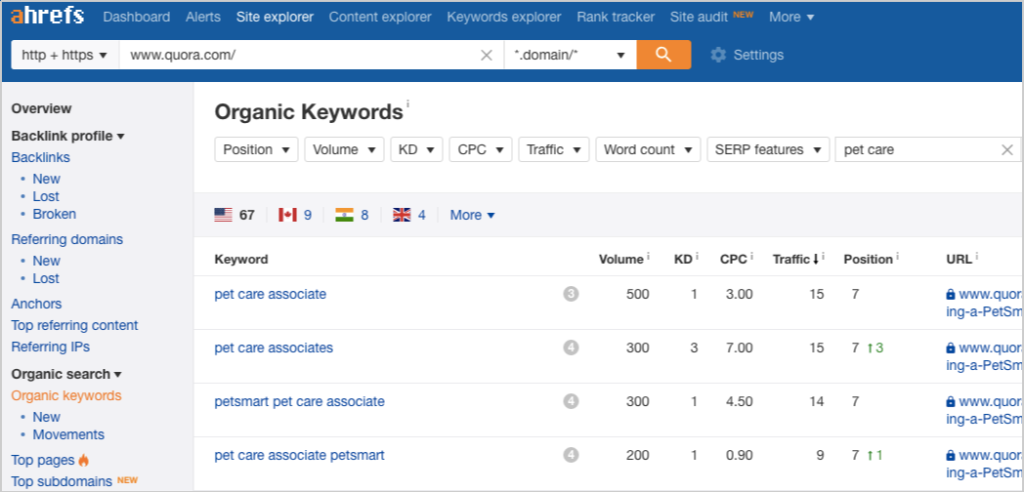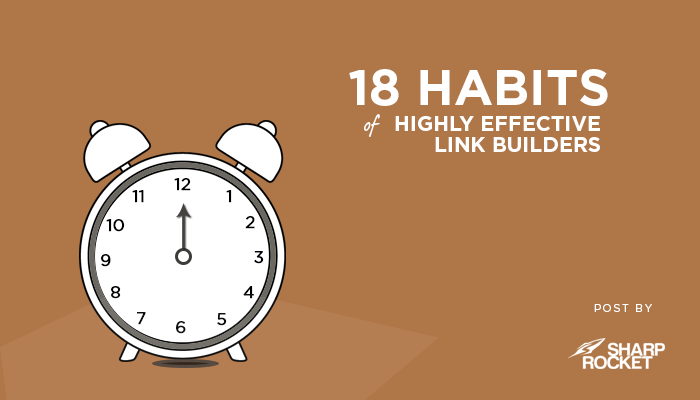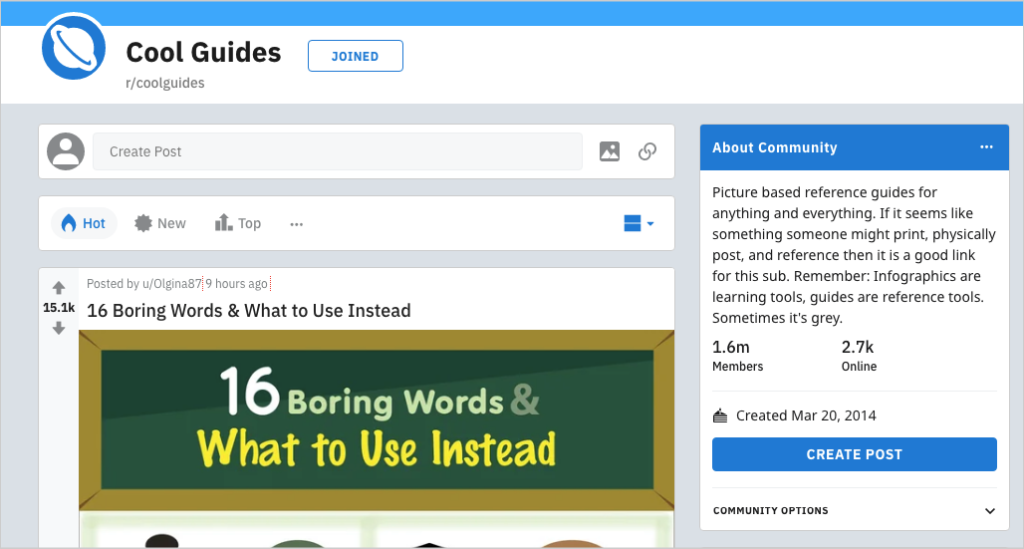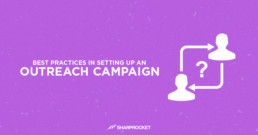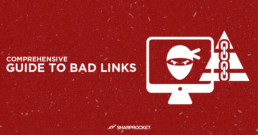How to Report on Links
Reports depending on the type of arrangements you have with your client or brand.
If you're doing it in-house, the report on links may be part of your overall search performance reports. It means it is geared towards the impact of links that have on your organic search.
Of course, there are so many factors that can get your site's to rank (besides links) and you couldn't simply separate the link factor itself as the sole indicator of success — increase in organic traffic for a specific month - let's say.
However, if you have a page solely investing your resources and efforts into building and earning links, you could have a report for the improvement of the performance of that page.
If you're working in an agency (or you own one), the same thing may be applied if you're offering full-suite SEO. What you want to do is to ensure those links you've built have helped the website attain its desired organic rankings and traffic.
How to Report on Links
Here are three simple steps to help you make reports on links:
- Make your reports easy to digest with emphasis on the business value of links
- Assess the progress and small wins
- Discuss next plans of actions
1. Make your reports easy to digest with emphasis on the business value of links
There are many samples of link reports available out there, but one thing you should deeply understand is the idea of simplicity.
The moment your client/in-house team/CMO looks at your report, could they easily digest the information?
Bar graphs, pie charts would only make sense if there is a proper orientation on the value of links for the brand — especially if you're dealing with business owners who desire more revenue from their online businesses.
2. Assess the progress and small wins
Link building is an ongoing campaign and doesn't stop after you rank that one content guide or landing page.
As long as you need more revenue from your business and drive more traffic through search, you've got to strategically invest in link building.
Assess the progress of the campaign. If you're dealing with clients, don't let them second-guess your work. They need proof that what you're doing has a business impact on their brand. Check again the BI approach to link building to give you more insights on the topic.
3. Discuss next plans of actions
Progress requires planning. Whether you do it internally with your SEO team or collaborate with content teams of your clients or the business owner itself, you want to make sure you make plans.
Whether it's planning for more targeted links to a specific landing page or creating linkable assets, do it in a concise and organized manner.
Let me walk you through some of the link reports you can generate to show the performance of links.
What Types of Reports to Generate?
1. Prospecting and Outreach Inputs
For big brands (or enterprise link building), normally have reviews of every prospect list. This helps them ensure that your agency follows guidelines in terms of metrics you've set beforehand.
That's the reason why it's extremely important to manage expectations at the start of the campaign. Specifically on what link metrics both you (agency) and your client/brand will agree upon.
Those reviews of clients require a prospecting list, which includes:
A. Total qualified sites
Based on agreed metrics, the report shows the list of websites (or just the total number of prospects you've vetted on) and have passed the benchmarks (relevance & authority) through proprietary metrics and a keen eye on quality.
B. Total contacted sites and responses
In most cases, this particular list isn't included in the report anymore. In-house managers or contact persons for link building assume different contact rates and response rates for each link development campaign.
However, some managers are granular in their approach that they tend to look at those contact lists, and even ask response rates from time to time.
2. Basic Link Deliverables
Common link reports are deliverables.
These reports may typically just be in a spreadsheet or pdf form.
Details include:
A. List of live link URLs
This is a no-brainer. You want to show the exact pages where you got links from.
B. Proprietary metrics
Alongside link URLs, you should be including other metrics such as the Site's DA/DR and the Site's estimated organic traffic (using Ahrefs/SEMRush).
These are handy reports you can easily outsource link building or hand over to your junior SEOs. As simple as it sounds, the organization of all these live links, when done for years, will be time-consuming.
So you want to make sure you have a spreadsheet or a data collector to organize this for yourself or your team.
C. Number of acquired links per month
For large-scale campaigns or for agencies with multiple clients, you want to have handy reports for all campaigns showing the number of acquired links. It could be automated as possible to easily generate it when you need it the most.
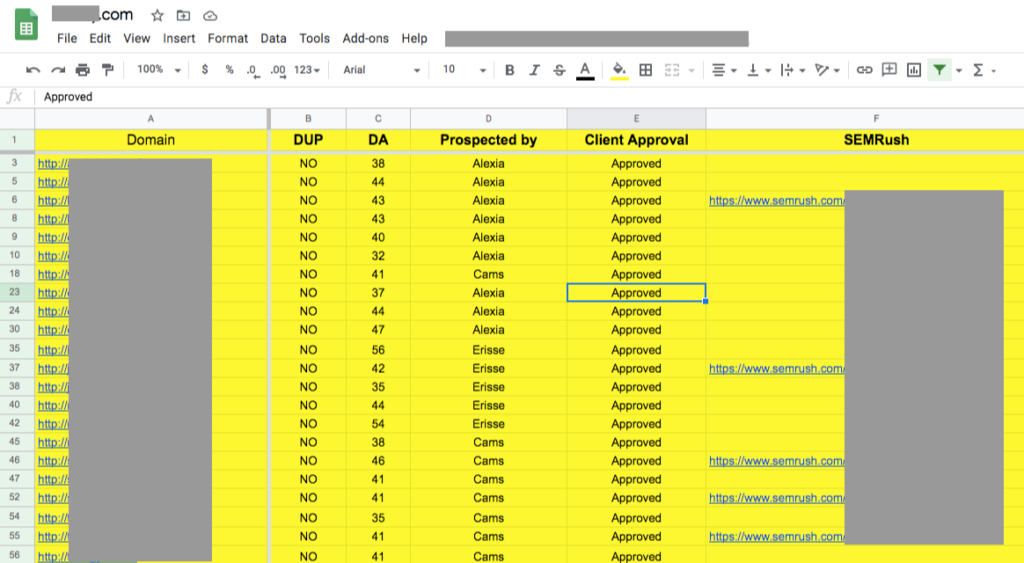
3. Impacts of Links
More than lists, what you should focus more on when generating reports is the value of links it has for the brand.
Regardless of the types of links, is the site bringing value to the overall site performance?
We've covered lead and lag measures before, but let's reiterate it again here.
When you're just asked to generate links, you're not just trying to hit as a leading indicator. Links could hit a lagging indicator of search traffic.
The defining value of links that you're acquiring is the rankings of the content piece you're creating (a specific page) you're building links to. That makes a lot of sense for business owners as this creates and manages expectations from a search traffic perspective.
A Business Intelligence Approach To Link Building
Cody West covered a comprehensive BI approach to link building which gives you more details on different factors to add to your reports.
Tactical
This answers the questions of how many links do you have to build next month or quarter of the year.
Based on the backlink gap between your site and your competitors, you'll then strategize how to position yourself in the market by targeting a certain number of links with a good benchmarking of link metrics.

You could add this section to give your client a more detailed view of what to expect from a link building perspective.
Tip: Make sure you balance it with the notion that links aren't only the moving indicator of success for rankings. They should consider other aspects of SEO to better expect more results from the overall search campaign.
Resources
Based on the resources you have, how much will cost you to generate a link? And long does it take you to hit your acquired number of links per month?
If you're an agency, the resource section of reports should be reserved for you. This will help you and your junior SEOs to start conversations around the following:
- Price of links — given you can calculate your cost per link per client, you can assess if you'd like to increase your price per link — assuming you're offering link building as your stand-alone service.
- Outsourcing link development projects — is it worth your time to do it in-house or should you hire an agency to do white label link building for your clients?
Answers to questions may not be part of your reports for clients, but only for internal use (in-house). This gives you a well-meaning approach to how you will attack your internal link building management.
Value and Cost
Link building budget may just be part of another expense report of your client or your company (if you're in-house).
Nonetheless, if you focus, emphasize, and lean more towards the business value of links, you're likely to get more buy-in, approvals for more business investments on this crucial and vital aspect of SEO.
Content Production For Links
What is content production?
Content production is the art of understanding and defining the right audience and of discovering ways where to put content pieces on a website, in such a way it is visible to the users.
Content production is both a science and an art. It deals with systems that help scale the production of content assets - whether visual or written, such as videos, blog posts, or whitepapers.
A proper workflow of activities streamlines the process and makes it more possible to develop higher-quality content assets on a consistent basis.
There are no guidelines or a proper framework for content production. As much as people are trying to box things, it wouldn't be possible given the diversity of audiences, industry market, and the way things are changing constantly.
In this post, we'll dig into some non-conventional ways to produce content assets in your industry.
INVERTED BROKEN LINK BUILDING IN CONTENT PRODUCTION
There are a plethora of online assets on any subject and if you'll take a look at your industry, you would find hundreds of blog posts on your chosen topic.
If you're starting and you want to produce content that gets links, you can start by reverse engineering other assets that have done well in the past in terms of link acquisition.
While this sounds to be the skyscraper technique, but you may do an alternate approach of focusing on dead pages that acquired links in the past.
Look for pages that have been brought down by the creator but previously gained link traction.
If you're doing link prospecting for resource pages, you can start running through the page with LinkMiner to find any dead pages with a substantial number of referring domains.
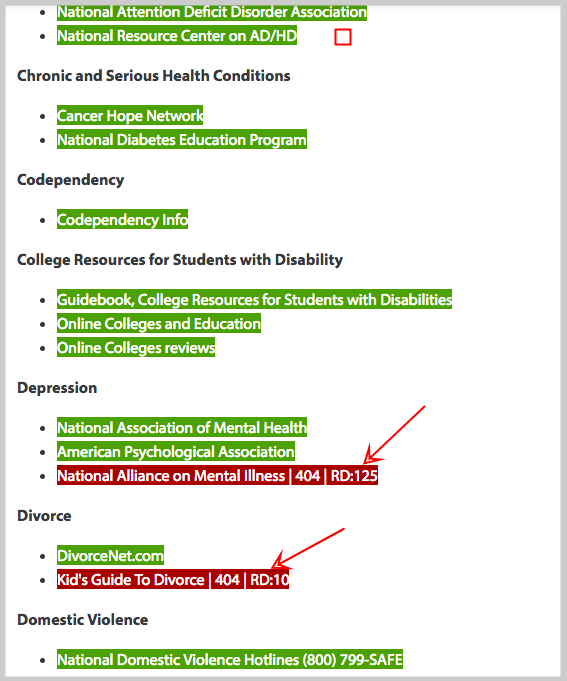
Check the live version of the page using archive.org and assess if it's relevant to your content strategy.
This exact process may be time-consuming and isn't scalable as it is uncommon to find highly linkable dead links on any resource page.
With that, you can use Ahrefs' Content Explorer to simplify the process. Ahrefs recently added features that allow content creators to find dead pages on topics.
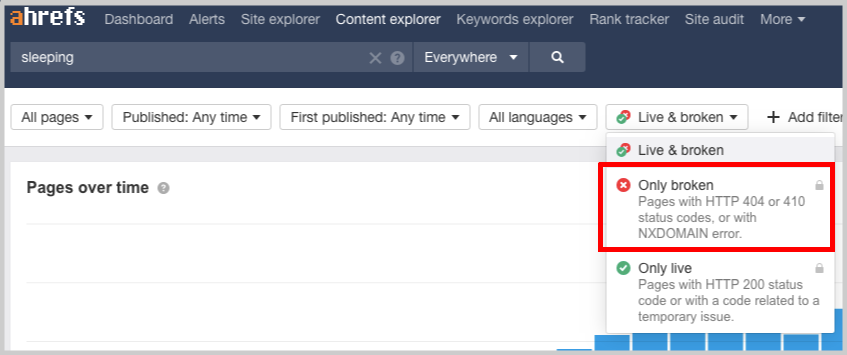
Input the industry keywords and choose only broken in the Live & broken dropdown menu filter. Go through the search results and sort it by referring domains.
Assess which ones are fitting to your brand. Develop the content asset, link to the original source for data and information if needs to be. Reach out to people who have linked to the original source and to linkers of similar content assets.
FINDING RECENTLY PUBLISHED CONTENT TO REPLICATE
If a blog post (or any page) has been recently updated, there seems to be a reason behind it--either it was just updated to adapt to the current year's information or it was perceived to be valuable enough. Getting organic links and social shares over time could help content perform better and attract more links if updated.
You can use the approach of looking for re-published content. And not just republished, but is perceived to be so valuable enough to reformat and update again.
Ahrefs' new feature of published and republished dates makes this process practical. Search for any keywords in your industry and use filters of published and first published date filters. A concrete example is to find pages that have been first published from 2000 to 2010, and have been published from 2018 to 2019.
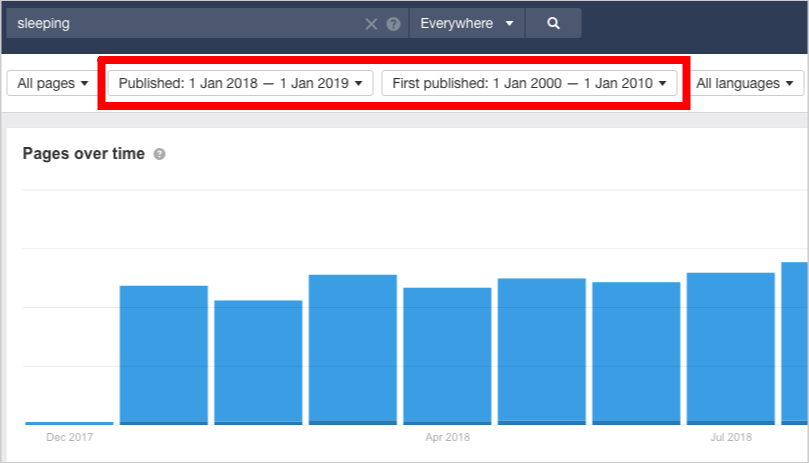
Add referring domains as your filter and make it to a minimum of 100 referring domains.
Go through each title of the page and click on ones that make sense to your business. Get inspiration for your site's content ideas.
CONTENT PARTNERSHIP THROUGH DISCOVERY OF AUTHORS
In the field of link building, there is more to consider than just the process and systems. While most SEOs are fond of pushing scalable processes, there is one thing people shouldn't neglect after all - that is relationships.
Partnering with any publishers for content production is one good way to produce higher-quality articles as two or more authors can validate the information and texts on the page.
You can do simple Google searches to find authors in your industry. Dig a little deeper and search for websites they've contributed works to. 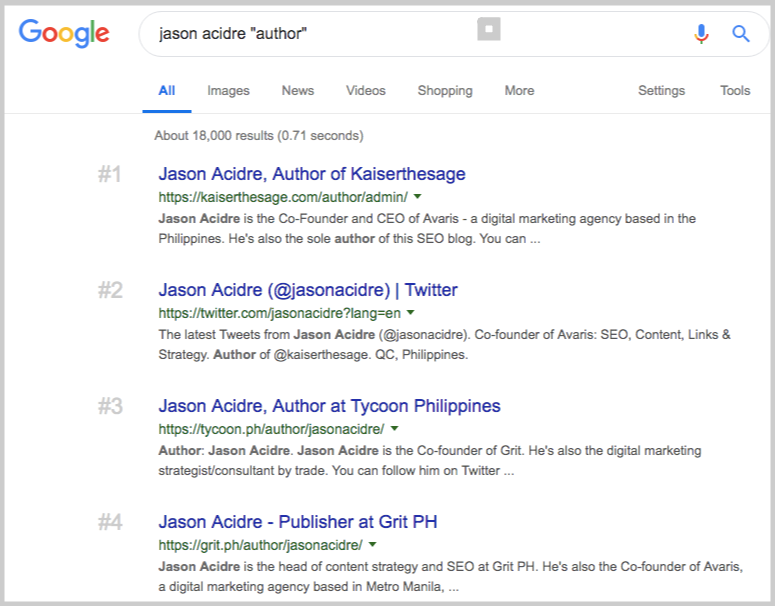
With Ahrefs, you can already see all other content written by the author using the tools' 1-click filtering. You may find more websites and blogs that may not be industry-specific, but are audience targeted and still relevant to your potential customers.

There are a lot of benefits one can derive from discovering industry authors and websites. Here are some of them:
- Allows you to find industry blogs and publishing sites where you can pitch for "guest posts".
- Helps determine the niches and sub-niches these authors are focusing on and where could these intersect with your brand.
- Discovers tangential markets your content production team can tap onto to expand your markets in audience targeting.
- Can be a way to collaborate with other content authors for huge web assets - it may be daunting at first to reach out, but if you also have substantial followers, there's a higher likelihood of success for mutual collaboration.
Here are more useful resources on content creation and recreation:
- LinkBaiting: Creating Content That Attracts Links
- Creating and Developing Content Assets Like A Pro
- The 38 Most Creative Ideas I've Ever Seen
CONTENT PRODUCTION FOR LINKS
At times, you don't have to always reinvent the wheel. There are content producers in your industry who have done so well in crafting and promoting content assets that get links organically. Get content inspiration from these linkable assets and you can even reproduce a few highly linkable content for your site.
If you're in need of outsourcing link building projects, you can check out our services page or directly contact our team for a consultation.
Why and How Influencer Outreach Works
What is influencer outreach?
Influencer outreach is a marketing discipline of identifying influencers in an industry, qualifying them based on relevance, clout, and engagement, and pursuing them by adding value to what they do.
It is a common practice in different outreach campaigns. The only difference is that you are reaching out to an influencer.
What is an influencer?
An influencer is an entity or a person with a massive reach (social, web or offline), who also serves your potential customers with content in their preferred platform.
When influencers endorse an offering from your site or a content asset you recently produce, you gain reach from their existing fanbase. You also have the chance of absorbing their followers if they've found your content useful to them - which is the primary win for any brand that engages in influencer outreach.
Besides that, there are many other benefits a brand can get aside from the absorption of their current following.
Value of Association
Trust is a glue and attractive force that makes people want to buy from you. It's common sense that when a trusted person or entity endorses what you offer to the market, it's possible that potential customers trust you more.
When you do influencer outreach, you actually take the risk of associating yourself with the influencer you're targeting. That's the reason why it's critically important to qualify influencers whom you would consider in a partnership.
The moment they introduce any of your page or content piece, you're letting them associate with yourself.
If the influencer has a good reputation and doesn't simply endorse any site/content, you're putting yourself in a respected position.
Though the influencer has limits as to when and how they would co-promote your offering/content, the value of association is priceless as it gives more authority and trust to your brand.
Content Marketing Opportunities
You never know how far your content will be able to reach once it's been part of the influencers' circle of content.
You might have a chance to get opportunities not only from the direct exposure of the influencer, but potential ones its (influencer's) followers might provide for you.
Future collaboration can take place when that happens.
While many marketers discuss virality as a guaranteed mark of a successful campaign, there still isn't a perfect formula to make content go viral.
With influencer outreach, you're increasing the probability of your content being more visible, rather than just guaranteeing its virality (though that might happen as well). The truth is virality comes from higher visibility of your content in different places.
Influencer outreach does that for you. It helps you increase your content's visibility in your target audience.
HOW TO DO INFLUENCER OUTREACH
There are many techniques you can find in several articles on this topic, but there are common initiatives you must be able to learn and execute well to effectively get results from this type of campaign.
I. SETTING YOUR CAMPAIGN'S GOALS
This is common sense, but I find marketers jump into outreach very quick without even knowing why they are reaching out to influencers in the first place
What is your goal? What are you trying to achieve in your partnership with the influencer? Is it to get a mention in one of his blogs with a contextual link to your site/page? Do you want exposure in his non-text content (podcast or Youtube vlog)? Do you want to collaborate for a solid content piece that can dominate a keyphrase with high search volume?
Go deeper into asking the purpose of your campaign. Get a piece of paper and write it down.
II. IDENTIFYING INFLUENCERS
This initiative is the first activity among all influencer outreach campaigns.
Next to knowing your goals, you discover who you are reaching out to. And this is the part where campaigns will vary.
There are tools to help you semi-automate the process of discovering influencers in your industry. Let's discuss a few of them.
A. Google Search
The basic methodology of discovering potential influencers for collaboration is by doing Google search.
Use any of these queries to find influencers in your space:
- "top bloggers" INDUSTRY
- "author" site:TOPINDUSTRYBLOG
- "top influencers" INDUSTRY
You can also discover influencers who are contributors to a blog in your industry. See the search query I used below.
B. Ahrefs Content Explorer
Not only that you'll be able to find the most popular articles in your niche using Ahrefs' Content Explorer. You can also locate influencers who have tweeted those top content pieces.
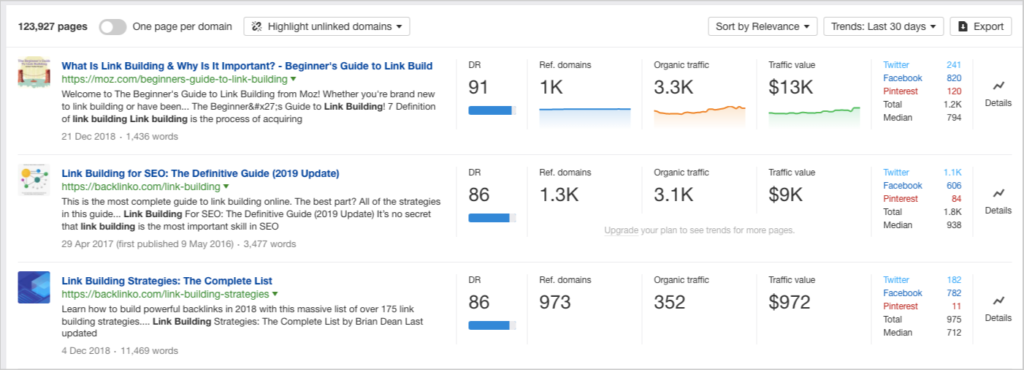
After searching for the topic of your choice, you will see a list of the top pages for that topic. For each content piece, there is an available Details button which you can click on to see more information about the article.
Click on "Who Tweeted" and there you'll have a list of influencers who have tweeted the article.
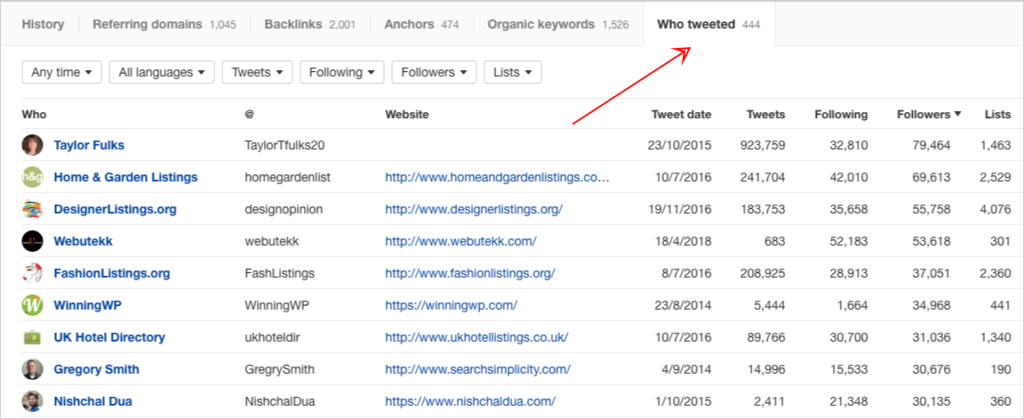
You can filter the list based on the recency of their tweets, the language they speak of, and the number of following/followers. Export it into a file for later use.
C. Buzzsumo
One of the most useful web-based products for influencer discovery is Buzzsumo. Its Influencers feature allows proper filtering.
You can filter the list by the type of influencers that you want to engage with: bloggers, influencers, companies, journalists, or regular people. This refining keeps your campaign more targeted to a specific group of influencers.
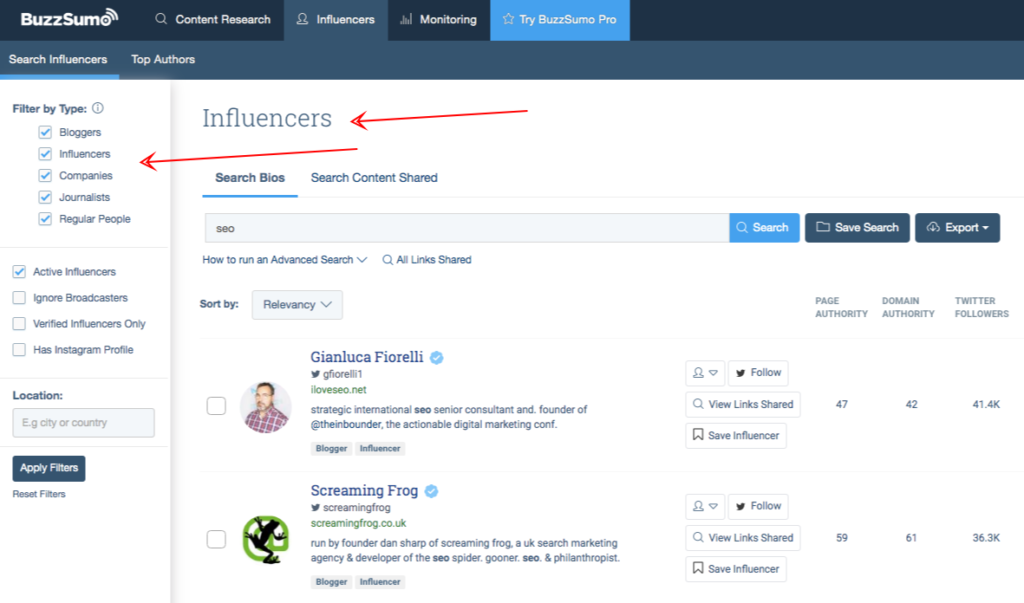
For local influencer outreach campaigns, you can filter influencers based on location.
Buzzsumo gives you options to sort the list of influencers from highest to lowest following Klout, retweet or reply ratio, and average tweets.
Maximize the use of those three tools: Google search, Ahrefs' Content Explorer, and Buzzsumo in order to make a solid list of influencers for your content marketing campaign.
After setting goals for your influencer outreach campaign and discovering suitable influencers, your next activity is to think of a strategy that makes the content more valuable for both parties - I call this valued partnership.
III. CONTENT PARTNERSHIP
You will not send emails to your target influencers without thinking of the value that you'll provide for them. With several priorities they have, they only respond to emails that are worth their time.
One value you can provide to them is content that both of you will benefit from.
Here are some examples of effective content partnerships you can consider to your campaign:
A. Twitter Chats
Twitter isn't only a place for ranting complaints, but a good platform for learning conversations.
For example, there are brands in the digital marketing industry that regularly hosts Twitter chats where they invite special guests (agency owners and consultants) to join their discussions for topics they specialize in.
If you have a substantial number of followers in your Twitter account, you can use Twitter chats as a value proposition in your influencer outreach pitches.
Invite influencers to join your weekly discussions.
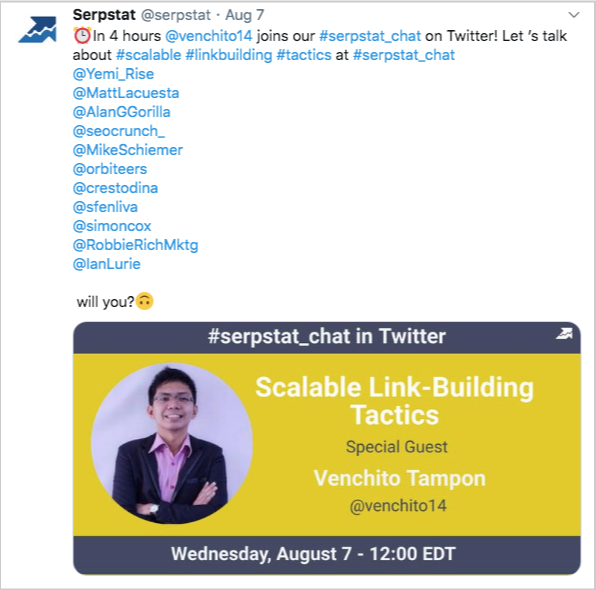
It's important to have a solid strategy for Twitter chats, and not just make it an ordinary discussion. One way to maximize it is to prepare questions related to the influencer's expertise. This would allow a more fruitful discussion with the community.
B. Video and Blog Interviews
Creating more useful content than what others have previously produced is now a challenge for content publishers. With much data and information published every day, a content piece must have a non-generic message people would actually consume at their best capacity.
This problem leads to content fatigue. It happens where there are excessive production and data of content that makes people become less and less receptive to the message that the brand is trying to send to its audience.
The solution to this problem is to collaborate with influencers for a solid content piece both parties will benefit from.
By doing influencer outreach campaigns, you can hit two birds with one stone-- engage an influencer while at the same time providing unique content to your target audience.
Produce an interview-type of content where both parties are able to discuss different yet thematically-relevant subjects.
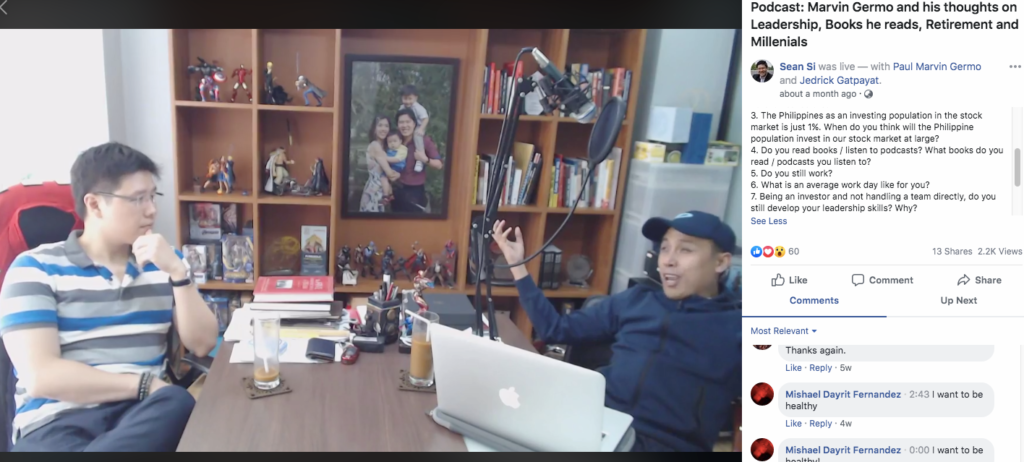
By doing so, both parties may absorb followers (subscribers) from each other.
C. Free Accounts
SaaS companies provide free accounts of their web-based products to publishers and influencers. While this should be an easy strategy for some, I've seen SaAs brands fail to get buy-ins from influencers to use and promote their products to their followers. One of the reasons why it happens is because they don't emphasize the value of their products.
The key in crafting your email pitches to influencers is to understand what makes your SaAs tool different from its contemporaries. There may be just 1 or 2 features that you need to highlight and focus on in your pitch.
D. Facebook ReShares
Facebook is a great platform to absorb followers from different asset pages. If it's done well, you can gain a massive following in a short period of time.
One of the effective techniques I absorbed in the past years that worked really well in increasing the visibility of a brand page is collaborating with other pages that target your audience.

By developing partnerships through content supported by both entities, you'll be benefiting from each other’s additional organic visibility and increase of influence and authority in your niche.
IV. MORE INFLUENCER OUTREACH TECHNIQUES
Content is definitely a valuable asset that you can offer to influencers. However, getting your pitches into their hands will require some additional techniques.
These influencers are getting several emails every day, so you have to make sure you do the necessary methods to get in front of their inbox.
A. Start with small-scale interaction
The ideal scenario is to pursue A-list personalities, but reality-wise, if your brand isn't well known and isn't that authoritative, the best recommendation is to start with a small-scale set of influencers.
As you develop relationships with low-tier to mid-tier personalities, you'll realize they would open more doors of opportunities for you - connections with other levels of influencers or a higher-tier network of friends they know.
That process allows you to step by step build your own networks of influencers. It surely takes time, but the methodology of small scale interaction gives you leverage over a wide variety of connections.
B. Do pre-outreach engagement
Learn to know more about your influencers. It's not enough to quickly pitch them with your products or content piece.
If they haven't seen you in their circles, they're likely to ignore your outreach email.
It's very basic, but one of the best ways to increase the effectiveness of your campaign is to engage with them before pitching.
Share what they've posted on Twitter - a retweet with a comment that actually reads the article they wrote.
A sign up to their webinar or email newsletter to get to know what they're up to - the interests and the value they're looking for.
Craft your emails in a way that it attends to your prospect's interests and needs. If you can write emails from scratch without any template, this will help hone your influencer outreach skills.
IDENTIFICATION BEFORE PERSONALIZATION
You can't personalize your email pitches without identifying interests and needs you have to provide to your prospect influencers. Do due diligence to profile them intently so you can write emails that best give value and not just want to get something from them.
Strategy for Follow-Up Emails to Link Prospects
In this blog, I've covered a lot of topics pertaining to outreach, from pitching bloggers, finding contacts' email addresses to making tweaks to certain outreach facets to increase response rates.
But one that I haven't discussed yet is on the subject of follow-ups.
There are four realities that I can base on my experiences about the importance of sending follow-up emails.
First, follow-up emails may remind non-respondent contacts about what they've missed in the initial pitches you've sent them. They may read the entire message, but have forgotten to respond unless they've had follow-up tools like Followup.cc and Boomerang to remind them to reply.
In reality, not all links you'll be building every month will be generated from your initial pitches. At most and you should base it on your own testing, you'll find that a huge percentage of your links may come from your follow-up emails. This speaks of the second important reason for such activity.
Failure to follow-up initial non-respondents is a missed opportunity to get the desired links.
Lastly, follow-up emails may speak of your persistence in sending value-driven messages to your contacts. However, doing so aggressively may affect how your site/brand may be perceived to be offering value whether in a form of content submission, collaboration, or any potential brand equity.
There are a few points I have to make in this post and may spark some ideas for you to A/B test and see which option may work for you.
1. New email with the original message or email sent as a reply to the initial pitch
There isn't any better email practice between these two options. One has more advantages than the other, and vice versa.
When you send new emails with the original message, you may recoup what has been an error in the first email. Strictly check why it hasn't been sent in the first place - it may be an erroneous input from your end - such that, a wrong email address. Receiving a bounced email for the second time is a clue to that.
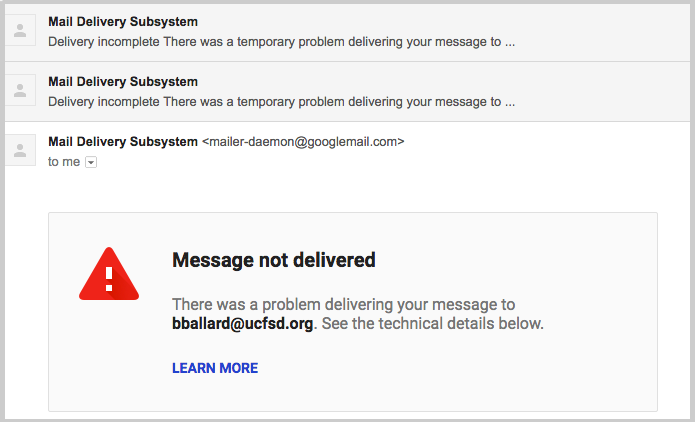
Sending new emails can also give you the luxury of trying another email subject line that may at this time, capture the eye of the recipient and can get your email to be opened.
Follow-up emails sent as a reply to the initial pitch can best work if the original message has been opened and read, given that it'll also have a chance to be opened and read as well.
One drawback from that is that the recipient might have to click on … to see the previous message, which may add friction to the conversation.

Both of the options: new email with the original message and email sent as a reply to the initial pitch may work in different circumstances. There are many variables that may come into play for follow-ups, but can be an interesting item to A/B test against to see which option is significantly more effective than the other.
2. Channel non-respondents with social accounts
In general, there are three ways on how to approach outreach with social accounts like Twitter.
First, ask for the contact's personal/direct email address. It'd be easy to engage in conversations when the email is valid and is directly accessible by your contact. This will help avoid back-and-forth emails as to who you should reach out to for a certain matter - the inclusion of a link request on one of their pages, for example.
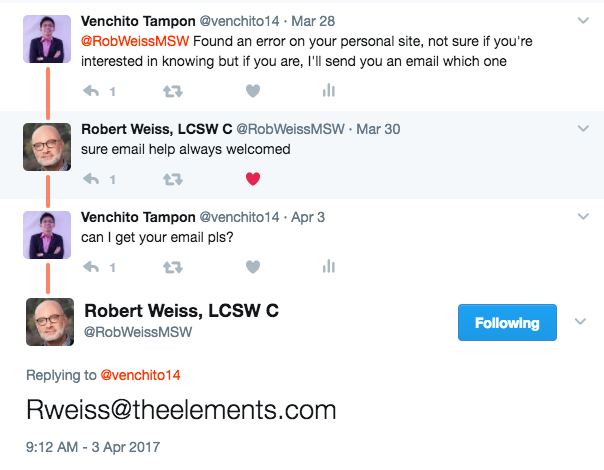
I've covered this outreach technique in my post about building contextual links - you may want to check that out.
The second is to directly pitch your contact using Twitter after several outreach attempts with no replies. Unlike the first approach where you'll get the contact's email address and channel it back to your email conversations for engagement, what you'll need here is basically identifying the Twitter profile and pitching your message straight.
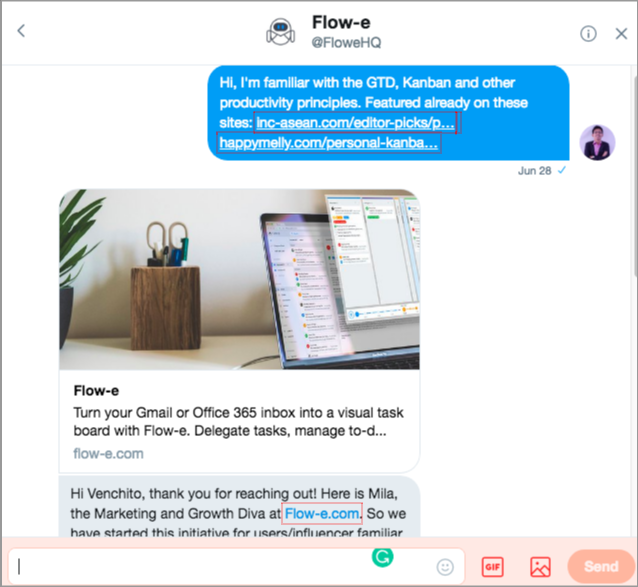
The third approach requires a considerable amount of time to get some returns. If you have sourced your contact from Twitter, either you've seen him being recommended as a top contributor in your niche or have siphoned him from a public Twitter list of bloggers or influencers.
Let your contacts know where you've found them by using lines such as, "I saw you as a recommended blogger follow on Twitter and wanted to follow" instead of "I'd like to make a follow-up" - which is useless to say.
3. Following up on engaged link prospects
There's a natural tendency to follow-up link prospects when they haven't responded yet, or just waiting for a confirmation of a link acquired or content being submitted for review.
If you're reaching out to people who've previously linked to similar content pieces (e.g. resource page curators), the basic recommendation is to not give them any instructions, since they're natural linkers. In the first place, they usually know what to do next - either to link or share your content, which really depends on how useful your content is to them or to their audience.
So, in what scenarios would you send a follow-up email to an engaged link prospect?
For guest contribution, a follow-up email to an editor who's been reviewing your content for a while but hasn't responded yet is worth considering, for reason that they may have almost forgotten to review your content or they made it into a final draft, but haven't notified you.
Just make sure to keep your follow-up email short and to the point. No need to overload them with information you've already given them; just give them a reminder and get the conversation going again.
There is no particular set of rules here, but as you go through conversations, you'll be able to find the right timing to follow-up link prospects and to identify which contact person needs follow-up or not.
Need help with your outreach campaigns? Check out our link building services here.
How to Get Featured in Link Roundups
What are link roundups?
Link roundups are curated content of the recent and most outstanding content of industry publishers and content creators published either daily, weekly, monthly, or annually.
Here are a few examples of links we’ve got for Digital Philippines (my own link building blog):
- http://www.pageonepower.com/linkarati/linkarati-roundup-48
- http://www.highrankwebsites.com/article-roundup-my-favorite-posts-in-internet-marketing-this-week/
- http://seocopywriting.com/seo-content-marketing-roundup-week-ending-may-22nd/
- http://citationlabs.com/link-building-seo-roundup-fall-2014/
Why get a link from a link roundup?
Active searching
Unlike any other content creator whom you will pitch for link inclusion, link roundup creators are actively looking for great content to include in their regular list.
It’s hard to consistently produce link roundups in your niche as you have to actively find the latest and valuable content from bloggers, otherwise, visitors of regular link roundups won’t come back.
In this case, you are actually initiating the favor for them. By giving your own great content, you’re helping them to find the best posts in your industry.
Recurring links
What I liked about link roundups is that once you’ve established relationships with these content curators, you could get consistent recurring links from them. This consistency obviously depends on the quality of content produced by your brand.
Your potential links won’t end there. When industry publishers find your content in one particular link roundup that might be an additional link on your end when they start to reference yours in their own content marketing.
First burst of links to get your site
If you’re mainly targeting long-tail keywords or a non-competitive keyphrase, those first sets of backlinks you’ve acquired from link roundups can help you reach the second page or even the first page of search results. These may lead you to earn more links from industry researchers on your topic.
How to prospect for bloggers who publish link roundups?
There are three easy ways to find link roundups in your niche or in a thematically relevant industry.
1. Use Twitter to find link roundups
Twitter is one of the underestimated search tools when looking for regular link roundup curators. With a quick search on link roundup queries, you’ll get a handful of bloggers curating full-links content like this one.
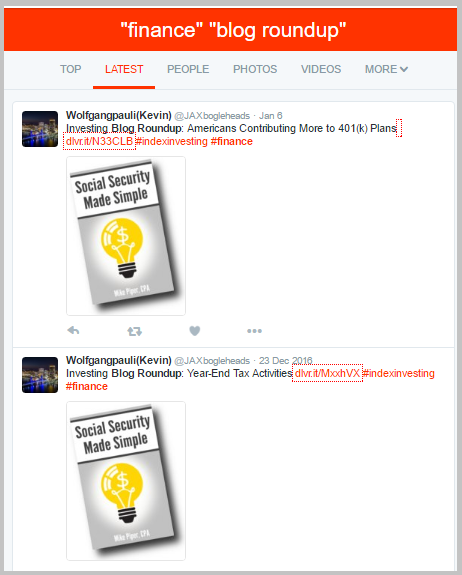
2. Google search queries
Besides Twitter, you’ll obviously get tons of results from search engines themselves.
Go to your favorite search engine and use any of the following search queries
- “KEYWORD” "best blog posts"
- “KEYWORD” "best blog updates"
- “KEYWORD” "best blogs updates"
- “KEYWORD” "best pieces of content"
- “KEYWORD” "best posts of the month"
- “KEYWORD” "best posts of the week"
- “KEYWORD” "best posts this week"
- “KEYWORD” "daily link round up"
- "KEYWORD” “daily round up"
- “KEYWORD” "favorite posts of the month
- “KEYWORD” "favorite posts of the week"
- “KEYWORD” "friday link round up"
- “KEYWORD” "friday round up"
- “KEYWORD” "monday link round up"
- “KEYWORD” "monday round up"
- “KEYWORD” "monthly link round up"
- “KEYWORD” "monthly round up"
- “KEYWORD” "notable posts"
- “KEYWORD” "notable updates"
- “KEYWORD” "posts of the month"
- “KEYWORD” "posts of the week"
- “KEYWORD” "round up"
- “KEYWORD” "roundup"
- “KEYWORD” "saturday link round up"
- “KEYWORD” "saturday round up"
- “KEYWORD” "sunday link round up"
- “KEYWORD” "sunday round up"
- “KEYWORD” "thursday link round up"
- “KEYWORD” "thursday round up"
- “KEYWORD” "top posts of the day"
- “KEYWORD” "top posts of the month"
- “KEYWORD” "top posts of the week"
- “KEYWORD” "top posts of the year"
- “KEYWORD” "tuesday link round up"
- “KEYWORD” "tuesday round up"
- “KEYWORD” "wednesday link round up"
- “KEYWORD” "wednesday round up"
- “KEYWORD” "weekly link round up"
- “KEYWORD” "weekly round up"
- “KEYWORD” best blog posts
- “KEYWORD” best blog updates
- “KEYWORD” best blogs updates
- “KEYWORD” best pieces of content
- “KEYWORD” best posts of the month
- “KEYWORD” best posts of the week
- “KEYWORD” best posts this week
- “KEYWORD” daily link round up
- “KEYWORD” daily round up
- “KEYWORD” favorite posts of the month
- “KEYWORD” favorite posts of the week
- “KEYWORD” friday link round up
- “KEYWORD” friday round up
- “KEYWORD” monday link round up
- “KEYWORD” monday round up
- “KEYWORD” monthly link round up
- “KEYWORD” monthly round up
- “KEYWORD” notable posts
- “KEYWORD” notable updates
- “KEYWORD” posts of the month
- “KEYWORD” posts of the week
- “KEYWORD” round up
- “KEYWORD” roundup
- “KEYWORD” saturday link round up
- “KEYWORD” saturday round up
- “KEYWORD” sunday link round up
- “KEYWORD” sunday round up
- “KEYWORD” thursday link round up
- “KEYWORD” thursday round up
- “KEYWORD” top posts of the day
- “KEYWORD” top posts of the month
- “KEYWORD” top posts of the week
- “KEYWORD” top posts of the year
- “KEYWORD” tuesday link round up
- “KEYWORD” tuesday round up
- “KEYWORD” wednesday link round up
- “KEYWORD” wednesday round up
- “KEYWORD” weekly link round up
- “KEYWORD” weekly round up
More link building search queries: Search Engine Queries Cheatsheet
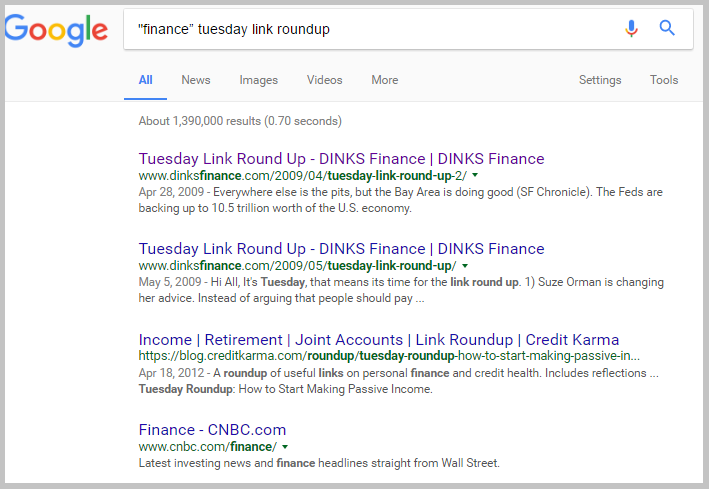
Qualify them based on a number of things and put “industry link roundups” to your spreadsheet (head over to “how to quality link roundups” section of this post).
3. Reverse engineer top industry blogs
If you’re trying to search for more link roundup curators in your space, try scraping top blogs and see their latest backlinks.
Hand a top industry blog’s URL over to Ahrefs.
See their newest backlinks by going to the Backlinks section and clicking “New” (see image below).
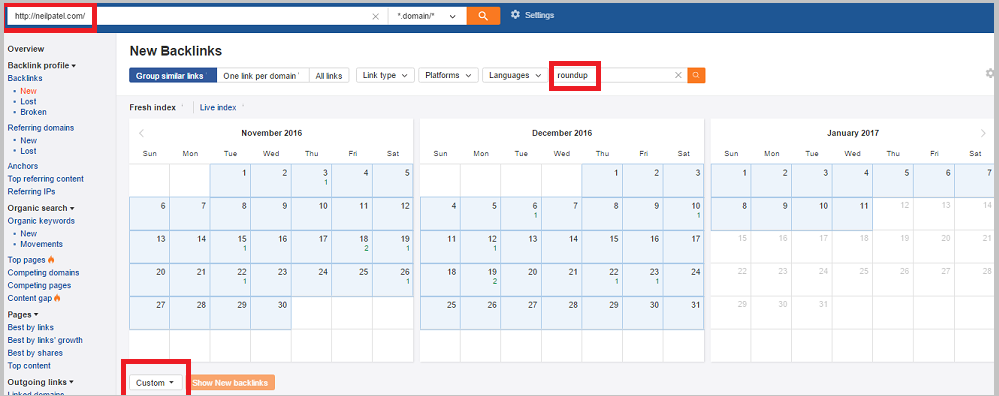
You can customize the time period so you can see more results in the backlinks section. For example, I’d try to click on November 1 then on January 11 (which is the current date today). This way, I’ll be able to see results of recent backlinks of Neil Patel’s blog for the past 3 (almost) months from November 1 to January 11.
To find the goldmine link roundups in the newest backlinks section, simply type “roundup” or “best” (for “best of the day” or “best of the week”) in the search function to filter only recent backlinks with “roundup” in its title or URL.
Once you do that, you’ll get to see a couple of link roundup curators that you wouldn’t just find simply through Google search or Twitter function.
A couple of examples of link roundups I came across on Neil Patel’s recent backlinks.
- https://thewebatom.net/blog/november-webmaster-resources-roundup/
- http://dkspeaks.com/weekly-link-roundup-content-promotion/
How to qualify link roundups?
I highly recommend that you qualify link roundups as you go searching for them. This way you’ll incorporate to your list of blogs (on a spreadsheet) ONLY qualified link roundups.
Here are my qualifiers for link roundups?
External not internal links
Include in your spreadsheet link roundups that point to external links (or at least half of the links should be external). Don’t bother to outreach someone that curates his/her own resources alone.
Informational content, not products
Your VA or a link builder might include every link roundup in your space. But not all of them will be useful for your link building campaign. Those link roundups with all items and products listed aren’t a good use for outreach – you won’t acquire a backlink from them unless you promote a product yourself.
Frequency of link roundups
Not all link roundups are usually curated regularly, other industry blogs stopped doing so. Make sure each link roundup you’ve listed has the most recent link roundup on their blog (if it’s weekly, make sure they’ve posted a full-link content a week ago).
If you’ve found one old link roundup (e.g. “best of posts” “industry” September 2016), check it on Google and change the “all time” search function to past week/month (depending on the frequency of the link roundup).
See if there are results that pop up which show that they still curate the best articles and blog posts in your niche.
How to organize link roundup spreadsheet?
Documentation is key to scaling this link building process to all of your clients. Though it’s no guarantee that this link roundup strategy can be used for any verticals, having a list of industry full-link content can help you easily acquire links for a new client in the same industry as your other ones.
No rocket science when organizing a link roundup spreadsheet. The only details you need are:
- Domain name
- Roundup URL / Sample link roundup (that’s the reason you have to find the most recent link roundup of the publisher)
- Roundup label/name (add their weird titles – i.e. “blog hop”, “link party – which may look at blackhats, but it’s just the name.
- Frequency (monthly/weekly/yearly)
- Blogger’s name
- Email / Contact form
- Contact form (if the email is not available)
- Relationship status
*Read further for finding contact information tips.
How to pitch to link roundup curators?
Pitching to link roundup curators is no different from other outreach campaigns: finding contact information, customization, and other factors that would make your emails get opens and responses.
Let’s first gather contact information. A few tips to find it:
- Check if the author bio has its name (or for most brands, it’s just “admin”). Then go directly to about us/team us (if it’s a company-looking site), then look for the direct email of the person.
- If it’s purely a blog, see the about page. If you can’t find it, subscribe to his/her blog, the email that he uses to send email updates are likely the same email he used for communication. Paste that contact info into your spreadsheet.
- If email is not available, copy and paste the contact form of the website (you’ll still have a high chance of getting responses though).
A few other places where you can find contact details if they’re not in the about/contact pages:
- Privacy policy
- Disclaimer/disclosure page
- Social media pages (Facebook/Google+/Twitter)
- Google queries (“name” + “email” OR ‘contact”) or (site:[domain.suffix] + “email” OR “contact”) or (domain.suffix + name + email)
Tools to find direct emails:
Further reading: How to Find Any Email Address: Seeking Email Superheroes
After you’ve completed contact information in your spreadsheet, you’re now ready for outreach.
You can use this exact email template below or have your own but make sure you follow these quick tips:
- Make your subject line straightforward (it could be too content pushy if you just include “consider this content in your next link roundup” or any similar subject lines). See the subject line below.
- Personalize by greeting the blogger’s name.
- Include the “link roundup label” in your pitch (a few bloggers have tens of link roundups on their blogs, especially if they’re a content curator). Make it easy for them to understand your pitch by stating which “link roundup” you’re looking to get placement with.
- Your content is key here. If your content is fluff, even if you push it to hundreds of bloggers, you won’t get as much links as you expect. Ensure your resource has unexpected hooks and had in-depth information on the topic.
Subject: Content for [LINK ROUNDUP TITLE]
Hi Helen,
I saw that you're doing a [FREQUENCY] round-up post on [BLOG NAME].
Would you mind seeing my recent post about [TOPIC]? It's a good fit to your weekly post as it tackles [WHAT’S IN YOUUR CONTENT].
If you want to see the post, here's the link: [LINK]
Please let me know your thoughts about the post, [NAME OF THE BLOGGER]
Kindest regards,
[ NAME ]
Further Reading: How to Leverage Influencer Outreach to Build a Better Blog Post
Your Turn…
Do you have any questions about link roundups?
Or maybe you have any insight or thought to add?
Either way, leave a quick comment below.
I’ll be more than happy to reply to comments and answer questions.
How to Promote Your Website Through Link Building
Website promotion is not rocket science. You can learn it in little steps. By understanding how it works and training yourself to apply the process, it won't take you longer to see results from your activity.
Today's post will not cover all the methodologies and practices in website promotion — there are so many and it’s impossible to cover in one post.
I'll focus mainly on website promotion through link building.
Link building, or link acquisition, can drive immense exposure to your website, given that links bridge websites where visitors can pass through. It helps drive visitors from page to page.
When a website is seen on a page, it gains initial traction, especially if the anchor text used was branded. It adds interest and provokes curiosity to the reader to visit the linking website.
Even in a linkless mention (that requires link reclamation), a visitor may be curious enough to do a quick Google search to know what that mentioned product or brand is.
In addition, link building does help in other forms of marketing initiatives such as:
- Introducing new brand ambassadors to the online space who are not just representatives, but are also evangelists of the brand's message, and of what the company contributes to the community.
- Increasing online visibility through enhanced off-page SEO factors of the website, which can help disseminate more awareness about the brand.
- Expanding new connections with web enthusiasts, influencers, and industry publishers
- Building authority and expertise through well-crafted content externally published on other websites
These, among other benefits, are exposure initiatives being affected by link building.
To execute a better website promotion campaign, you must first understand concepts in order to customize your approach.
Every website has these three components of a website promotion campaign: web assets/resources, means/channel, and authority & branding.
Let's discuss each one of them in detail.
WEB ASSETS & RESOURCES
It's critically important to know your website's inventory. It is basically a collection of all assets you currently have as an entity. These include the following things:
- Visual assets
- Brand personalities
- Internal data reports and industry surveys
- Lists of past contacts with industry publishers
- Ebooks and whitepapers
- Blog articles and other internal informational content pieces
By knowing your existing resources, you can craft a strategy that utilizes most of them. In fact, you don't have to think of producing new content all the time, all you have to do is to look at your brand's inventory and see which asset is best suitable to use in a specific website promotion campaign.
MEANS & CHANNEL
This basically means a specific place wherein you'll utilize your brand assets for promotion. It could be a website, a network, an entity or a subset of the digital marketing field you'd want to focus your efforts on.
In SEO, your approach for promoting your website involves technicalities (on-page SEO) and link building.
When you properly optimize your website in its on-page totality, the links you'll be building will benefit your website tremendously.
With regard to link building, your means of website promotion could either be any of the following:
- Industry micro-community website (fora)
- Q&A website with a niche section
- Social networks
- Email or outreach platform (Gmail or Buzzstream)
You align your channel to your resources. If you have infographics, for example, you may choose Sub-reddit for images and an outreach platform (for reaching out to publishers) as means of website promotion.
AUTHORITY AND BRANDING
The popularity of a website makes a difference in the results of a site promotion campaign. In blogger outreach, for example, if a brand is well-established in the industry, conversion rate (links to be built from publications) is expected to increase as publishers are already familiar with the brand.
Branding (how an entity is differentiated from its competitors) provides a cutting edge in link acquisition. When submitting a guest post to another blog and proposing a topic with your own unique twist, you're more likely to get a good link placement than when sending a guest blogging pitch with a generic topic proposal.
How to Promote Your Website through Link Building
STRATEGIC LINKING OUT
One of the easiest ways to get contextual links and receive initial exposure for your website is to start linking out to other valuable resources. By adding external links to your content to pages your audience will find informative, you are adding value to the web community.
Aside from including resources that will serve as references for your content, consider looking for recent blog posts and publications in your industry that have a high likelihood of reciprocating links to your page.
Check out bloggers who regularly publish content assets who are linking out to topical content. Link out to them once in a while, as you find their pages fit to cite on your own content works.
CONTENT CREATION
It's easy to go straight to website promotion without having a check and balance on what content is available on your website that adds value to the community. Given that without strong content that matches an audience, it's difficult to get backlinks.
Here are some actionable tips to get started with content creation:
ASSESS COMPETITION BASED ON TITLE MATCHES AND EXACT QUERIES
When you do keyword research, you normally assess competition based on the keyword difficulty score a specific tool has calculated for you.
Whether you're using Ahrefs, Moz or SEMRush, every keyword has its own difficulty score. This shows that if you want to target a keyword with the difficulty level of let's say 70 or above, it will require a higher domain authority website to compete for the top spots of search results.
Another way to assess competition is to use the intitle: advanced search operator along with the desired topic of your content. Search results will show you how many websites are targeting the same keyphrase with their indexed pages.
By using intitle search operator, you'll be too restrictive with your search results, leaving out articles that have other variations of your keyphrase. For instance, you have searched for intitle:"how to promote your website through seo", you won't see articles with titles, such as "Using SEO to Promote Your Website".
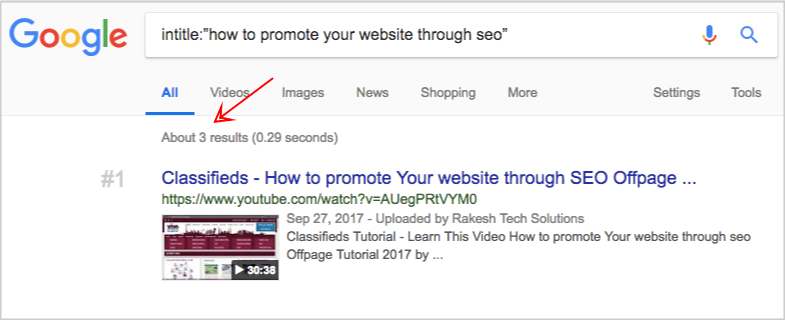
In addition to intitle search operator in order to quickly assess competition, you can make variations to check articles that fit to the category. You may use search queries like "website promotion" "seo", or "seo website promotion".
The reason you want to assess competition is not to bloat your blog with another similar article, but rather to ensure that there would be either a unique angle to the topic, haven't published yet topic so you may be the first to create or to target the exact keyphrase through long-tail form approach.
GENERATE LOCAL CONTENT INSIGHTS FROM YELP
If you're into local SEO, this technique can be a huge advantage for you.
Supposed that you want to produce more local sales pages, instead of going through the normal approach of using keyword research tools for key phrases like "pet care", why not reverse engineer a popular review website's organic keywords and see if they populate keywords you could target or haven't targeted yet for sales pages.
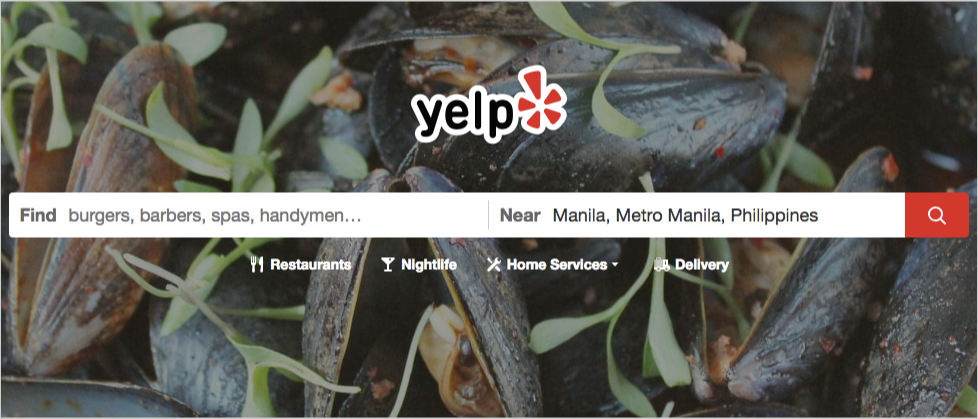
Start by entering yelp.com into an SEO tool of choice (I'm using Ahrefs for this example). Select their organic keywords section and filter results based on your industry topics.
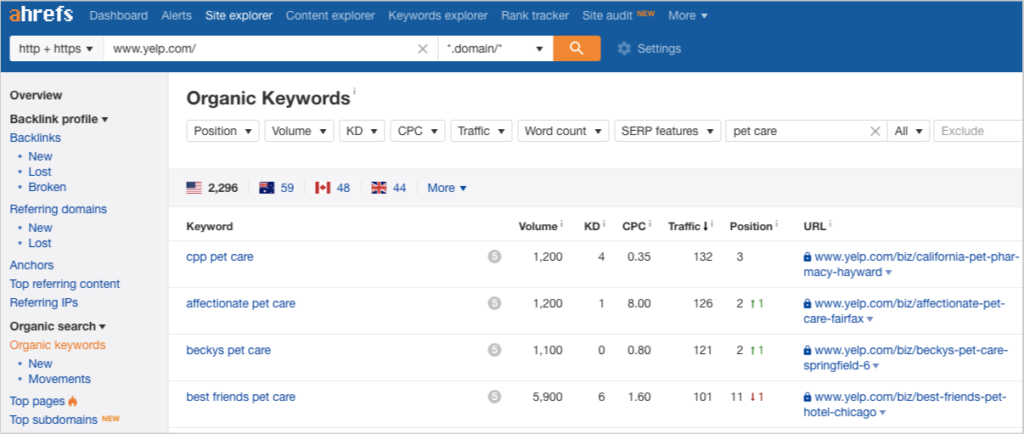
See for yourself which keyword is relevant to target for your local website's sales page.
REVERSE ENGINEER SLIDESHARE FOR VISUAL CONTENT
There are a lot of image link building strategies in the search space today, but one that's not really maximized to its full extent is reverse engineering top visual submission websites.
Slideshare, for example, dominates most of the reports, data, and visual-driven keywords.
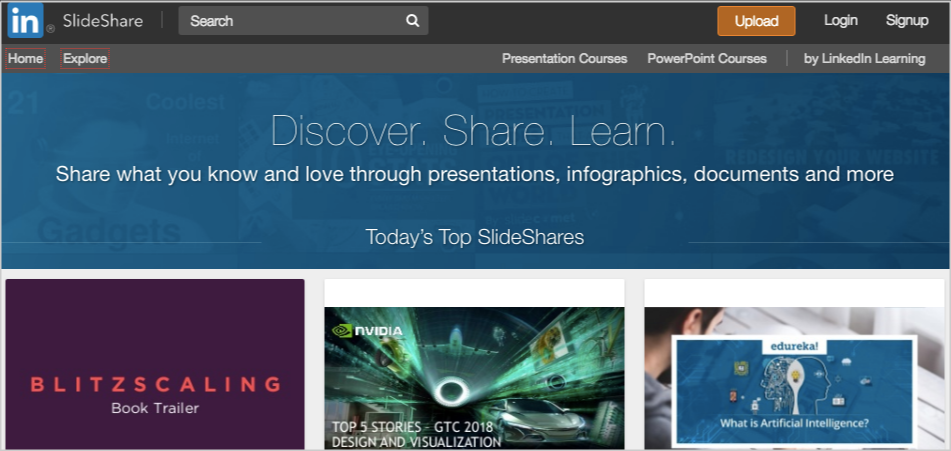
If you want to produce an infographic or create visual-oriented content, you can plug in Slideshare or other top visual websites and see what keywords they're currently ranking.
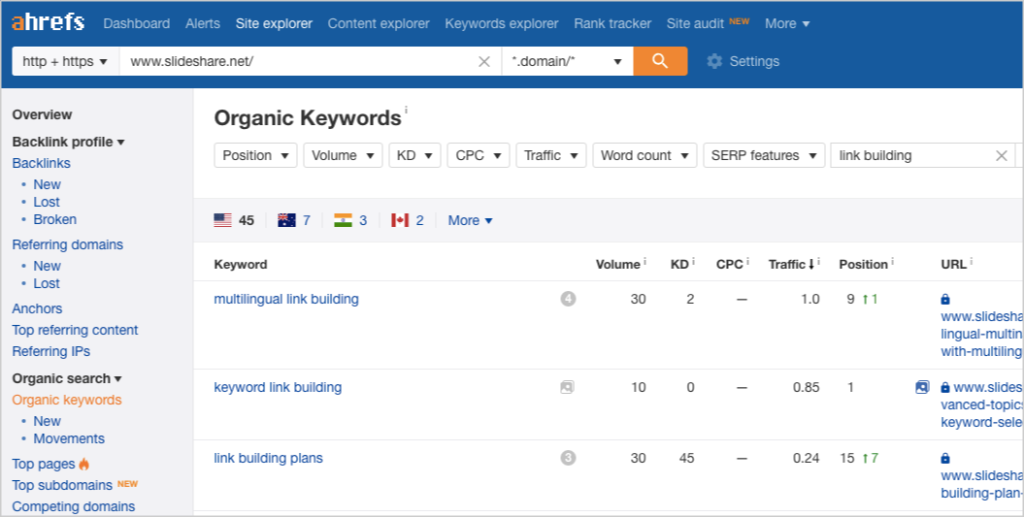
Filter these keywords based on your industry topics and assess which one you can target for your brand's visual content.
PUBLISH ARCHIVE OF STATISTICS
There is one powerful tactic that will help you consistently earn authority links over time and even get competitors backlinks, which is producing statistics content.
You can produce it internally if you have same data in place, or curate exclusive and premium reports from trusted statistic websites like Statistica.
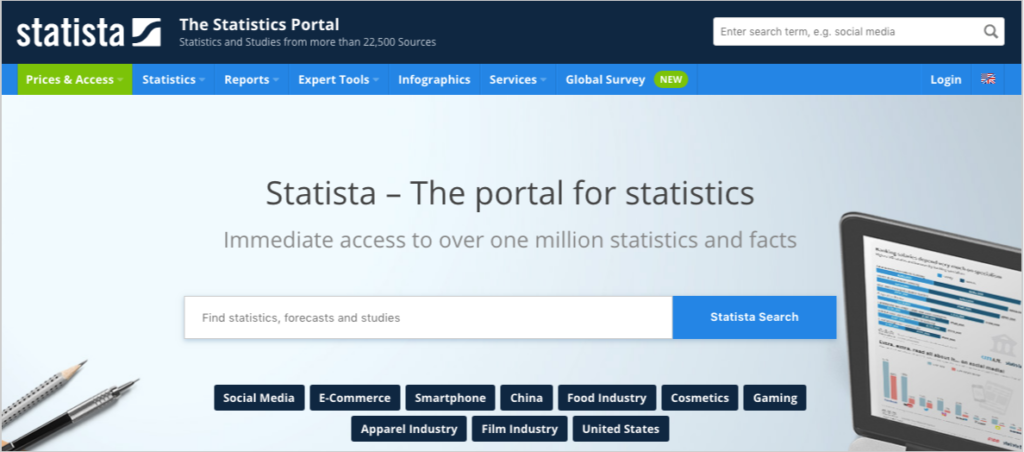
Moreover, if you see statistics reports brought up year over year, you can provide an entire archive of statistics on your website. Given that many people are searching for it every year, there's a definite value community is giving to such kind of report. In that sense, it's a huge advantage you can get if you have produced an entire archive of statistics.
REVERSE ENGINEER CONTENT WITH REDDIT
Reddit is a good place to develop your audience. It has only been misunderstood these days by some marketers banned because of their manipulative tactics to get more visibility in their subreddit of choice. But if you do things properly, you can get repetitive traffic from the website by submitting or putting out content.
One way to reverse engineer success in Reddit is to use Buzzsumo. Buzzsumo has an incredible feature of giving you Reddit engagements similar to the usual number of social shares (Facebook, Twitter) you see in every URL.
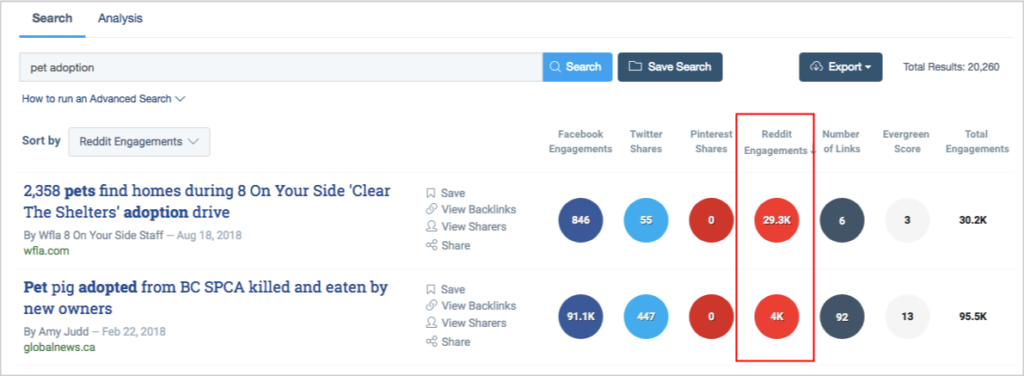
By looking at Reddit engagements, you can assess if the topic of your choice has the potential to get massive traction in its specified Reddit.
It's lazy behavior to make an assessment of the traction of a topic based on the overall total score from social shares and other websites' engagements. Given that each network or site has its own set of audience (with its own culture of engagement, interest, and style), it would be reasonable to stick on looking at one engagement score, in this case, Reddit engagements alone.
If you can find a topic with good potential engagement on Reddit, you can craft content that is suitable only for a subreddit.
One way to get the most out of your Reddit initiative is to submit content's URL to a subreddit during optimal times. You can use a tool like Later for Reddit to schedule your post at your desired day and time.
PROFESSIONAL ORGANIZATIONS
One way to promote your website is to make use of the professional organizations your company or entity has been a partner of.
There are Chambers of Commerce, industry professional organizations, and other similar sites you can contact for further promotion of your brand.
There are entities that will require recurring payment, some would love just a donation in exchange for a feature on a page or on a magazine or exhibit event.
Whatever it is, make sure you find them first and reach out to them whenever you see them fit your brand.
Start your link prospecting process by using any of these search queries:
- “KEYWORD” Business Association
- “KEYWORD” Directory or Business Association “CITY”
- “KEYWORD” Chamber of Commerce
- “POSTAL CODE/ZIP CODE” Chamber of Commerce
- “POSTAL CODE/ZIP CODE” Directory
- “INDUSTRY” association “STATE/PROVINCE”
- national “INDUSTRY” association
You can check out this guide for more search queries targeting professional organizations.
COMMUNITY ENGAGEMENT
Without any cost, every person can spend their time engaging the community. When I started my first blog, Digital Philippines (now redirected to SharpRocket link building blog), one of the things that I regularly did is to look for specific channels, networks, and websites I could provide value by asking and answering questions.
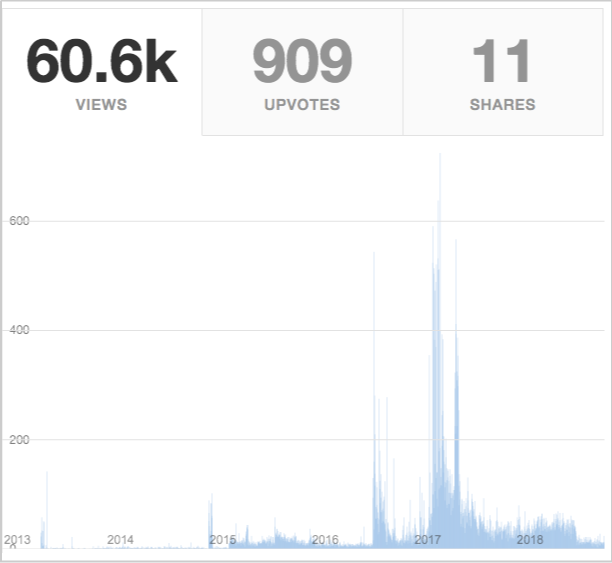
Most of the time, people think that you have to be an expert before you start going outside of your blog and looking for places for engagement. It's not the way industry practitioners work today. In fact, you'll find most of them just asking questions to one another, creating an Ask Me Anything section, and then rolling over conversations.
Here are some places where you can start promoting your website through engagement:
- Industry twitter chats
- Webinars
- Quora
- Community Blogs
It is important to monitor your performance in engaging the community and check which inputs will you give the maximum outputs in return.
One good approach is to choose specific questions on Quora that got traction already in the past and still getting more views given they're currently ranking for some informational keywords. If more people are searching for the question and have landed on the Quora question page, your answer may potentially get more exposure (adding up if your answer is marked as top answer).
DISCOVER AND PRACTICE
There are hundreds of ways to promote your website that I haven't covered here. But if you would like to take little steps in website promotion, start implementing the tactics above and see if they worked for you.
Discover more approaches to get traction for your website by reading SEO and link building blogs, guides, and ebooks. Practice them as soon as ponder them to be of use to you. There's no way you can say it works if you haven't executed it properly.
18 Habits of Highly Effective Link Builders
Many resources and articles recommend effective link building tactics, processes, and methodologies that are necessary to provide result-driven link acquisition campaigns. Unfortunately, they don't often give tips on how to become a better link builder in general.
Last week, I reached out to top link builders and asked them one question:
What are the best habits of link builders?
Here's what they said.
1) PERFORM SOLID COMPETITIVE LINK ANALYSIS

Julie Joyce, Founder of LinkFishMedia
I think that being able to perform a solid competitive analysis is key for any good link builder.
If you are part of a team and someone else does this, that's great too, but someone needs to be able to really sit down and critically analyze a profile. In my mind, one of the best pieces about this is from my lovely friend Jane Copland who wrote about it a few years ago. There have been many posts about competitive analysis but this one really sticks in my mind as being incredibly well done.
2) READ CONSTANTLY

John Doherty, Founder of GetCredo
The best habit of a link builder is constantly reading.
I think this is an important habit because link builders need to be aware who is writing online and where they write. The Internet has moved away from everyone having their own place to write and instead moved to a place where writers write for many different publications. You don't go to TechCrunch to read everything - you find a writer there you like and read all of their stuff.
3) BE PERSISTENT

Lyndon Antcliff, Founder of CornWallSEO
Yes they all mean the same thing, but link building isn't that complex. There are really only 3 ways to get a link. Ask someone for a link. Pay someone for a link. Build some content and hope that the people who see it will link to it (with a bit of promotion of course).
You can mix this up of course, but it's essentially all the same. I could drone on about various tools and the techniques of the day, but if you ignore the fundamentals you become a slave to those who are marketing tools and techniques.
Link building is very simple and there is no need to complicate it.
4) SET RSS FEEDS

Debra Mastaler, Founder of Alliance Link
Setting RSS feeds for a list of terms and reviewing them daily is the best habit a link builder can adopt. Keep in mind it matters less what you do and more where, and being first can often trump being "best".
Know where the sources are and what's breaking in your space.
5) GREAT FOCUS AND DISCIPLINE

John-Henry Scherck, Growth Marketing Manager of DocSend
The best outreach professionals that I know have great focus and discipline.
They don't check FB, Reddit, Twitter every twenty minutes. They diligently work through tasks and keep their heads down. They execute. They prospect more sites and send more emails. They are efficient.
6) READ AND STUDY CONSISTENTLY

Devin Harper, Marketing Director of Nifty Marketing
Understanding how and where to build links in a Penguin era doesn't come without consistent reading and studying. Link acquisition is the most difficult aspect of SEO to master and is often a struggle for online marketers. The most important habit link builders should develop is learning something new every day. The more you know, the more you can do. There's a lot of valuable material out there from Eric Ward, Michael Martinez, Jon Cooper, Garrett French and others who have devoted countless hours to mastering link building and they share their tips and tricks freely in most cases. Successful link campaigns all start with an idea
- and the more you read and learn about link building, the more ideas you'll generate when the time comes. A tool I use to stay organized and on top of my studies is Pocket. It allows you to save videos, articles and pretty much anything to read later.
7) BE PATIENT

Dave Schneider, Founder of Ninja Outreach
I think the best habit is patience. Link building takes a long time, even if you know what you're doing (which, most of us do).
It also comes with a lot of rejection, so in addition to patience add perserverance to the list. We've been building links at NinjaOutreach since early last year and we've tried a ton of different methods like product reviews, guest posts, and broken link building. In the last few months our traffic has increased 50%, so it pays off!
8) COMMUNICATE WITH EMPATHY

Dev Basu, Founder of Powered by Search
Communicate with empathy: a personalized message that shows that you've researched your link prospect will go a long way to getting a positive response. Don't forget to follow up: in-demand publishers and bloggers get a lot of email. Don't assume that they'll get your's if you don't follow up. The key is to have value added in your followup and to personalize it.
Ask contrarian questions: Pretend you switched places with your link prospect. Is the content you're getting pitched worth enough to link to if it were your own website?
9) IMPLEMENT OUTREACH WITH CONSIDERATION

Andrew Shotland, Founder of Local SEO Guide
Bathe regularly so your links are clean.
Do the things people aren't talking about. No one is giving away their best link building secrets. Implement your outreach with consideration for others' failures so you don't have to fail causing you to resort to expert roundups to attract links.
10) GROW YOUR NETWORK

Dan Petrovic, Founder of DejanSEO
Grow your network of contacts and friends at all times, not just when you need a favour.
That said, don't obsess over numbers. I recommend forming fewer, more genuine relationships that stem from a common interest, engagement or conversation. A great way to start would be to help someone out even when they're not asking for it or sharing their content with your followers.
11) ALWAYS CONTRIBUTE TO A PUBLICATION

Benjamin Beck, Creator of the Link Building Class
There are two common habits I see in some of the best link builders I look upto, they are: always contributing and fun or friendly outreach. Once you contribute to a publication it is much easier to contribute again. Also it makes it easier to contribute to other publications. These link builders have a lot of connections and can easily link to quality content. A lot of outreach I see in my inbox is dry and distant. When I look at the outreach of good link builders they are usually fun, friendly, and have much higher results.
12) THINK OF THE VALUE BEYOND RANKINGS

Marie Haynes, Founder of His Web Marketing
My number one rule when it comes to link building is to think of whether or not this link would have any value beyond improving rankings.
For example, a link on a high PageRank resource page that never gets seen or clicked on may not be as valuable as a link on a blogger's site that actually sends you traffic and clients. Each time I pursue a link I think, "Would I still be going after this link if it was nofollowed?" If the answer is no, then I have to step back and look at what I'm doing to make sure that I'm not straying outside of Google's guidelines.
13) BE ATTENTIVE TO DETAILS

Moosa Hemani, Marketer at SEtalks
This is an interesting question and answers can be different for everyone depending upon the experience they had. If you ask me here are the few habits that I want to see in any link builder within my team.
Attention to details – Link Building isn’t about sending template emails and asking for links. It’s about building relationships
and starting conversations over the email, social media or even on the phone. If a person has an attention to details, he must have an opinion on the subject, which can lead to conversations and later relationship building.
Reading Habit – This one is important. As a link-building you should read a lot. This includes books, blogs posts, articles, white papers and not only related to your own subject but about other industries (especially the one you are working for) as this will give you extra knowledge as well as an edge over others within the game.
Writing – No, I am not saying you have to be a full time writer in order to be a good link building but you should know how to sketch your ideas on paper in the form of words and sentences. This will help you craft the kind of emails (conversations) that help you get links and more.
These are the few things I would look for along with other things like, attitude of learning and growing as without it you can never be a good person in general.
14) BE TENACIOUS

Peter Attia, Online Marketing Consultant of Cucumber Nebula
I think the best habit is tenaciousness, even if it’s automated. What I mean by this, is making sure to continue to follow up.
For our link building process at Modernize, we follow up at least two times with every person we reach out to, no matter where they are in the funnel. So if we’ve been talking to someone and don’t hear back for a while, we reach back out at least two times afterwards to try and keep the conversation going. Overall, this accounts for a significant percentage of our responses.
15) BE CREATIVE

James Norquay, Director of Prosperity Media
- Someone who knows how to be creative.
- Someone who knows how to reverse engineer competitive link campaigns.
- Someone who is not afraid to email people at random to secure links.
- Someone who is not afraid to pick up the phone to secure a high quality link.
- Someone who has good work ethic and is keen to secure only the best links.
- Someone who has great English and knows how to structure outreach emails.
- Someone who can work for long periods of time to secure the best placements.
- Someone who has good motivation.
16) LOOK FOR THE TRUE VALUE OF A LINK

Steve Morgan, Online Marketing Consultant at Morgan Online Marketing
A good habit to have is to look beyond the pure SEO value of a potential link
, such as its DA (Domain Authority) score or whether or not it is dofollow/nofollow. For example:
- Does it have the potential to actually be clicked on and drive referral traffic?
- If it's something like a guest blog post, what's the site's social media following? Do they have lots of Twitter followers who might the see and RT the post, for example?
- Could it open up other, further opportunities? For example, leaving a blog comment (nofollow) on a site once opened up the opportunity to guest post (dofollow), as the blog's owner loved our comment and wanted to write a full-on post about it.
I've actually opted for lower-DA opportunities if I've thought that other (non-SEO) benefits could come out of it.
17) DEVELOP A PROCESS

Paul May, CEO and Co-Founder of Buzzstream
The two things I see people do that typically has the biggest impact on the success of their link building efforts are
- Before sending a single email, put yourself in the shoes of the recipient and have a clear answer to "what's in it for me?" Way too many people send emails that asks for a link without thinking through the reasons that the recipient would want to link to their content.
- Develop a thorough process that includes prospect discovery, prospect research, initial outreach, follow-ups and measurement.
If you nail down your workflow up-front, you'll be significantly more efficient and your conversion rate will improve.
18) ISOLATE WEB MENTIONS

Razvan Gavrillas, Founder of CognitiveSEO
One effective technique that I use is the Unlinked Brand Mentions Technique. I've created a habit of checking the cognitiveSEO mentions on a daily basis. Isolating web mentions is important.
From an SEO perspective, a web mention is completely different than a social mention. It's has a different impact on the rankings. We check all but regarding the link building perspective I will focus on the web mentions. We eat our own dog food and use the Brand Mentions tool for tracking the mentions. From time to time I get mention alerts regarding blog posts that mention our brand and don't link to our site.
Since the authors of those articles are already familiar with cognitiveSEO, getting a link from them is a breeze. We see response rates as high as 95% on the outreach that we do. If you are interested to know more about this, here is an in-depth article on how I build relationship and links using the unlinked brand mentions technique and not only.
I also don't build links, directly. I craft content that resonates with our readers.
Exceptional content gets exceptional coverage. It simply generates exceptional mentions. Those mentions are then converted into links using the technique mentioned above. Link building is mostly brand building these days. This mindset allows me to grow our brand ethically and organically.
Have We Been Helpful?
Want to take your link building to the next level – — but don’t know where to start, and are feeling overwhelmed by this post.
We are here to help you. SharpRocket is a team of link building specialists who love building high-quality links.
To learn more about how we can help, take a look at the services we offer.
How to Use Blogging For Personal Branding
What is personal branding?
Personal branding is the practice of marketing people and their careers as brands. It is an ongoing process of developing and maintaining a reputation and impression of an individual, group, or organization.
The term was coined by Tom Peters back in 1997 in an article he wrote in Fast Company entitled the "Brand Called You" article. Let's look at excerpts from his page.
"You’re branded, branded, branded, branded. It’s time for me — and you — to take a lesson from the big brands, a lesson that’s true for anyone who’s interested in what it takes to stand out and prosper in the new world of work. Regardless of age, regardless of position, regardless of the business we happen to be in, all of us need to understand the importance of branding. We are CEOs of our own companies: Me Inc. To be in business today, our most important job is to be head marketer for the brand called You."
While your resources may be limited in starting to build your personal brand, the benefits of it — an achievement of any personal or business goals, will outweigh any exerted resources.
The game to promote one's business and to establish authority to fulfill a certain objective is now open to as many individuals and entities due to the free market the web offers.
Anyone can enter the scene and start building their personal brand. By using the available resources online, you can now set up a profile that catches people's attention and deliver the most value to them.
In this post, we'll cover how you can use blogging, one of the major platforms, to build your own personal brand.
Benefits of Personal Branding
Authority. Though authority isn't quickly built by merely posting content online, you can't ignore the fact that a subject matter expert won't gain followers and credibility without content promotion.
A proper personal branding plan helps someone in building authority by turning his or her expertise into content distributed to a target audience.
Achievement of business goals. There are many founders and executives of brands who have started to create separate online accounts. It's the person now sharing life stories, answering questions from their brand advocates, and taking risks to be vulnerable to know more of them, not as a company, but as a person.
While doing so, they deliver the message of their companies in terms of mission, vision, and core values in such a way that it's more relatable to the audience they are serving.
There are many methods in building your personal brand, some of which you can do all at once. However, one channel you can start investing in, as it is very easy to start with is blogging.
How to Use Blogging for Personal Branding?
I'll give you basic practical tips.
Find your niche
Anyone can start talking about anything under the sun. An aspiring blogger can discuss parenting, leadership, businesses, fashion, or whatever topic she feels.
Of course, that would expand the horizon of the blogger and can cater to as many audiences as possible. However, tapping too many general topics on a blog isn't always a good option.
With too many publishers coming out every day, you would want to penetrate an industry with your differentiation. Tom Peters summarized personal branding as differentiation.
So what makes you different?
Knowing where your expertise lies is the first step in personal branding.
Your expertise comes from your technical exposure in the industry, from your education (both formal and informal), and from your professional experience.
By discovering your niche, you elevate your chances of standing out in the crowd. You avoid just being a "noise" in the industry.
For example, James Clear is a New York Times best-selling author. But he first started as a blogger bringing practical tips on habits.
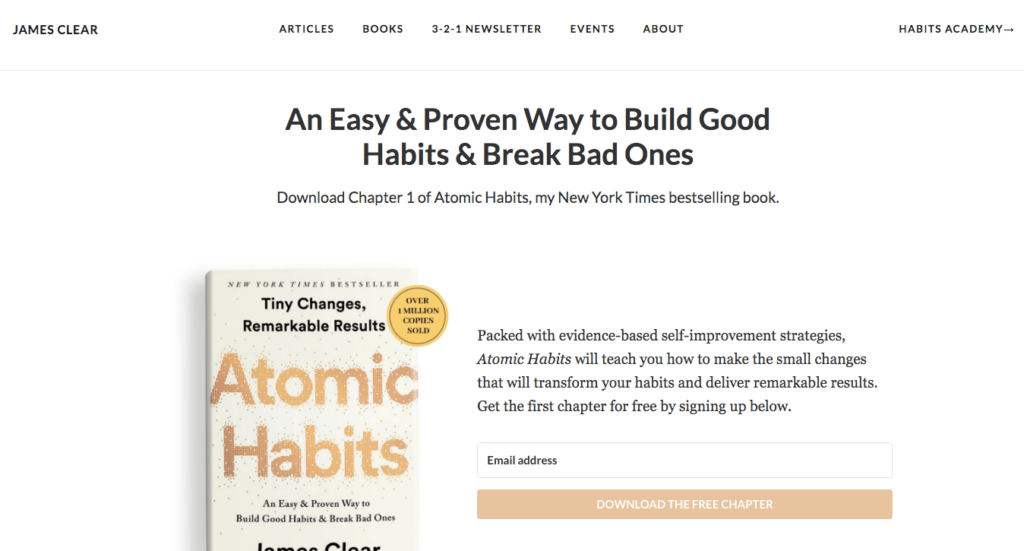
Any topic you would think on the subject of habits is covered by James. Whether that is habit formation, motivation, behavioral psychology, or procrastination, he took a deep dive into these content themes and explained them in a very relatable way to his readers.
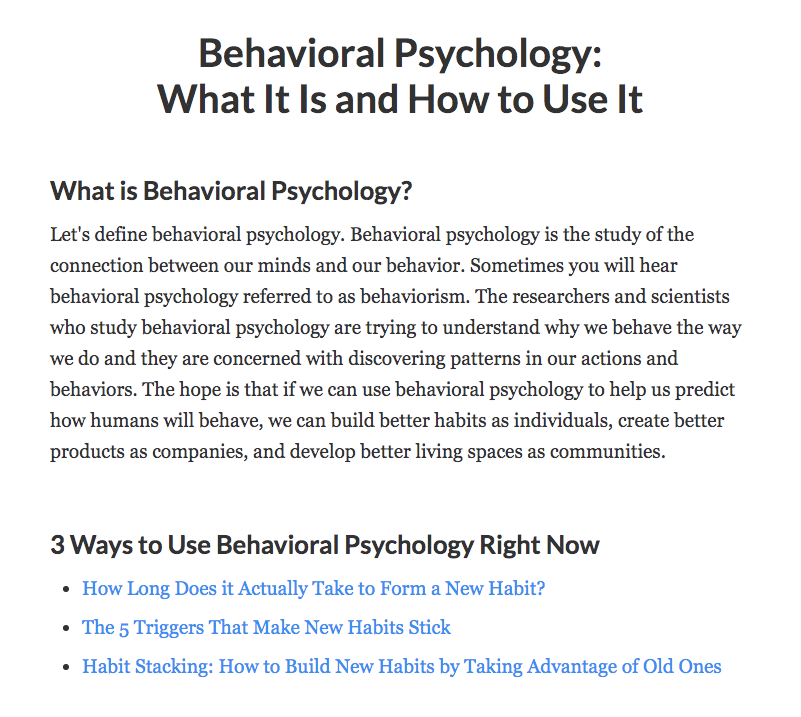
Here are some questions to help you discover your niche:
- What is one thing you enjoy doing? That speaks of your hobbies.
- What has been part of your career? That speaks of your professional experience.
- What is one thing you've been wanting to share with others? That speaks of your advocacy.
You may also use the "Hedgehog Concept" by Jim Collins to find your niche.

It is the intersection of three things:
- What are you deeply passionate about?
- What can be the best in the world?
- What drives your economic engine?
Take a moment to examine yourself. There you discover your preferred niche.
Know your voice and style
Your personal brand voice and style matter.
People will create an impression about you based on their first consumption of one of your content pieces. How you communicate through blogging helps them decide whether you are worth following through email subscription (a subscriber) or to your social media accounts.
Over time, your readers will find out what makes your content different from other niche bloggers.
Here are some tips to find your voice and style:
- What's your personality? Are you more outgoing or quiet?
- Who is your target audience? Your personal brand voice and style depending on how you want to serve your people.
- What is your unique angle on-topic discussion? How do you want to communicate your ideas?
Below are some resources on finding your voice and style as a blogger:
- Why A Writing Style Matters To Your Blog
- 7 Tips To Finding Your Writing Voice
- Problogger's Guide to Finding Your Blog's Unique Voice
Discover trending and in-demand topics
Identifying your niche, your personal brand voice, and style is planning how you can penetrate your niche market.
The way to move forward is to become a content creator through blogging.
Find topics that best resonate with your audience. I've covered content ideation in many of my comprehensive guides on this blog, check links below:
In addition, you can monitor trending topics using Exploding Topics. I highly recommend you subscribe to their newsletter to receive emails on the latest keywords that are gaining visibility.
Google Trends is another trend-finding tool that allows you to see some familiar trends from the past weeks.
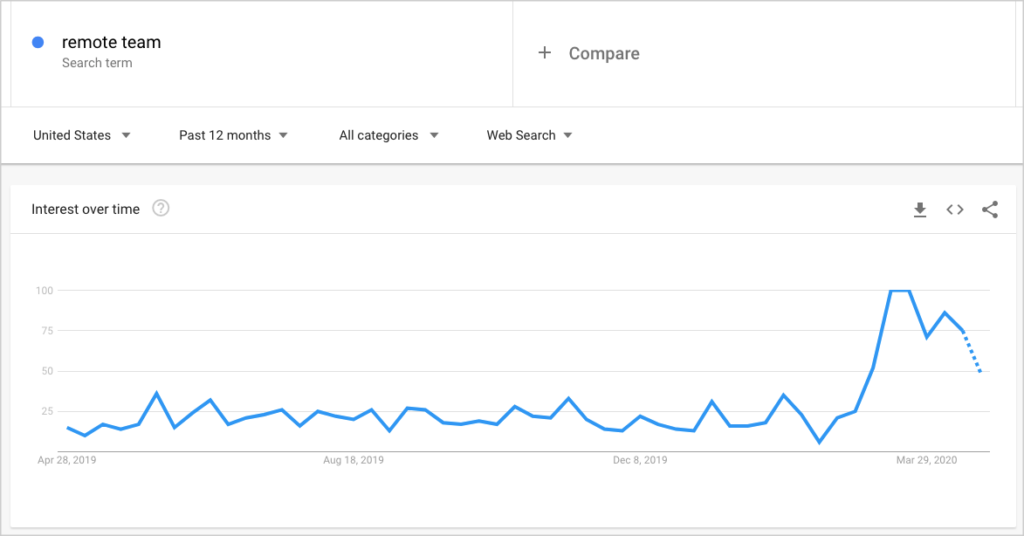
Dig deeper with Reddit by looking at what current conversations are taking place in your industry (see Reddit SEO Marketing guide). You choose subreddits to discover new topics or go straight to format-based subreddits (e.g. infographics, data, and cool guides).
Produce content consistently
Now, you transition yourself from a blogger who finds ideas to creating the blog content.
The ideal way for content production is to start an editorial calendar. This allows you to set aside time for writing blog articles.
By setting up a routine, you discipline yourself as a writer to put out articles on your blog. This avoids you procrastinating for days, weeks, and even months — wondering why you're not able to achieve the blog output you desire.
For further readings on consistent content production, here are useful guides you can consume today:
- The Ultimate Content Curation Guide For Marketers
- 10 Content Creators to Inspire Your Content Marketing
- 10X Content Ideation & Creation Process
Publish external content
When you are starting out as a blogger, there isn't a large network of readers following your blog.
The best way to improve your readership (increasing readers count) is by delivering external content to other relevant blogs (guest posts).
You increase readership by absorbing existing followers and content consumption of other blogs. Depending on the value you provide with your external content, you gain new visitors through blog links pointing to your linked content.
Here are some tips to get started with external content distribution:
- Start a blogger outreach campaign. Check these two useful guides on blogger outreach and guest blogging.
- Use Twitter effectively to let your social media followers subscribe to your latest content.
- Execute link building by discovering ways to market your blog content. Either reformat it into a video, audio, or slide presentation to get more eyeballs.
- Answer round-up questions and provide inputs to stories requested by journalists and other content creators. This is doable if you know how to use HARO.
Differentiate Yourself
Today, it's not just being better that is important. Being different gives you an edge in your industry. Discover your niche. Identify your personal brand voice and style. Create content that matters to your audience. Distribute it massively for effective delivery.
How to Start an Outreach Campaign
Starting an outreach campaign is easy. Executing it at the finest level is another story.
Outreach campaign initiatives vary depending on where you're at, what your goals are, and what are your available resources.
On Setting Up An Outreach Campaign
Where are you at?
I'm specifically referring to what you're currently working on. Do you handle clients as an agency? If that is so, is your agency focused on link building alone, or are you taking link acquisition as part of your SEO services?
Do you build links to a single website or to multiple properties of your brand?
Of course, you have some knowledge about this one. But knowing this is a must if you want to have a clear picture of your starting point.
What are your goals?
Have an end goal in mind. This speaks of what you want to achieve with your outreach campaign. Is it for PR purposes or are you trying to promote a content piece to get links?
An outreach campaign best works if it targets a specific goal/s.
What are your available resources?
Look at your current situation. Do you have any content specialists working with you? Any outreach specialists your company recently hired to become part of your team?
Did you subscribe to any premium tools? Buzzstream, Pitchbox, or NinjaOutreach, for example.
Not only should you be looking at your current resources, but you must also have an idea as to what additional resources you are willing to invest in. These include tools, more content and outreach specialists, or work offload from your current team members to be allotted to your outreach campaign.
Know these resources given as this will help fill in the gap between where you are and what your goals are.
How to Start an Outreach Campaign
There are certain outreach best practices to ensure an outreach campaign provides the most value to its end users (email recipients — i.e. potential linkers) and gets the most value in terms of content engagement.
Internal Content and Link Research Analysis
Start by knowing which of your current content assets you'll be using as bait for your outreach campaign.
Look at your existing blog assets. Which content piece has gotten relevant high-quality backlinks in the past? Once you've identified, check if there is still a market you can reach out with your evergreen content.
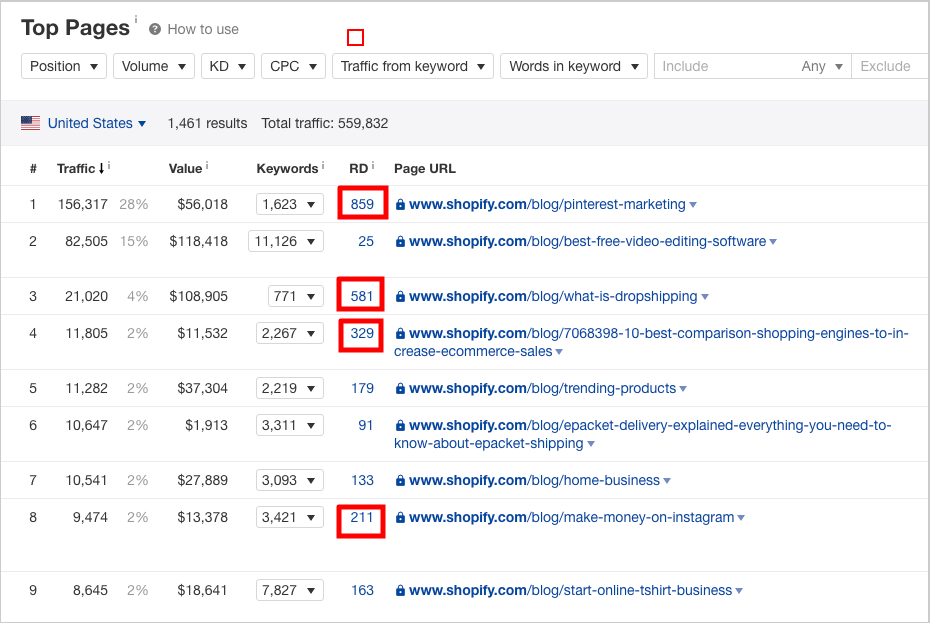
Outreach is tied to a specific content piece you are offering to the market. Start by knowing which makes the best offer.
Direct Extension of Prospecting to Outreach
If you think about scalability, you want to get the most out of your time for all of your outreach campaigns.
If you're handling multiple campaigns or even just for one website, one way to get more things done in less time is to extend your link prospecting initiative to outreach.
Instead of executing link prospecting and outreach separately, you can make them integrated by pulling some data from a third-party tool for gathered link prospects. Bring the targets directly to an outreach tool or platform for pitching.
You can use Ahrefs to pull some huge data of backlinks from competitors' sites (or other relevant sites to your brand).
On Ahrefs, you can qualify links through filtering by Platform (e.g. Blogs) and to One Link Per Domain. You can also use the included search to get only relevant pages. By including topical words, you exclude ones not related to your target campaign.
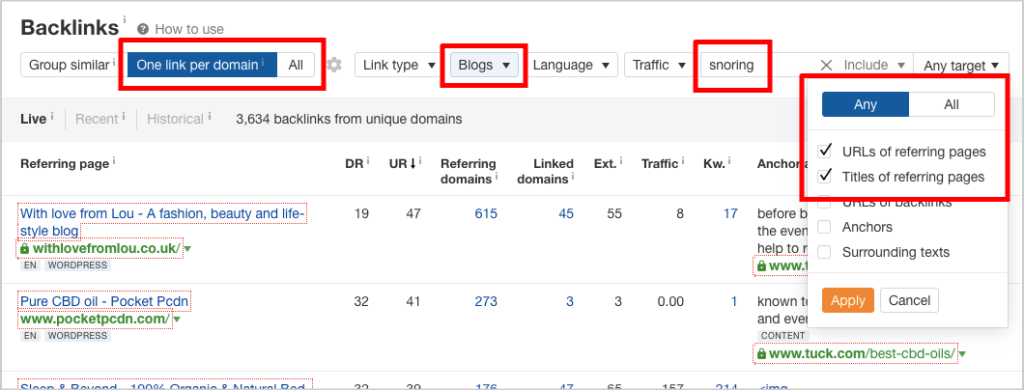
Once you've exported the links, you can strip the URLs to root domains using any URL trimmer tools: https://manageguru.com/url-trimmer
You may quality the links further for relevance by manually checking them one by one.
Input your list to email finder tools like Hunter and VoilaNorbert. Through any email outreach platforms or Gmail plus extension tools, you start sending outreach emails.
Outreach Segmentation
There are many link prospecting methodologies from different agencies and specialists on outreach. Those that have the most value include segmenting the list into different groups. This leads you to do some outreach for influencers or just for resource curators or blogger outreach.
Outreach segmentation helps you prioritize link targets based on your current link strategy, audience type, and potential link value the target page can provide.
Basically, metrics like Ahrefs' DR/UR, Moz' DA/PA, or Majestic's CF/TF can assist you in knowing which link targets are valuable.
But don't stop there. Look at possible link types. Are those websites more driven as PR or contextually driven for link building?
Segmenting your outreach lists also includes knowing which backlink prospects you've had connections with in the past. Given that you'll get higher chances of recurring links from people who've known or have interacted with any of your content, than someone you'll be reaching out to for the first time.
Organization of Prospecting and Outreach Lists
The simplest way to organize your prospecting list is to use a free tool like Google Sheets. If you're not really fancy with organization, you may start with spreadsheets and labeled columns for outreach details.
For bigger outreach lists, outreach platforms like Buzzstream, or Pitchbox will give you better organization for your outreach lists.
Here are some guides to help you with organizing your prospecting lists using spreadsheets and extensions:
- 100+ Google Sheets Templates
- 26 Best Free Chrome Extensions for SEOs
- Advanced Google Chrome Bookmarklets for SEOs
Quality audit on outreach templates
Scalability requires outreach templates.
While that gives you the leverage to speed up sending emails to hundreds and thousands of potential linkers, you care more of value than a mere personalization.
Fake personalization is worse than no personalization at all. @buzzstream found that a fake compliment such as "I read your post and loved it!" actually has a -1.3% impact on placement rate as compared to zero personalization.
— Ross Hudgens (@RossHudgens) May 7, 2020
Get some feedback on your outreach templates from the frontlines of your outreach team (ones who're in conversations with linkers).
Do some quality audits of your past outreach campaigns either for the same content piece or for a specific client outreach project (guest posts or resource page campaign you did)
Check conversations that have gotten you links and ones that don't. You'll have a better understanding of what makes your email resonate with the linker.
Follow up email process
What separates a successful outreach campaign from a mediocre one is a meticulous system for follow-ups. Most outreach teams take follow-up email structure for granted.
You miss a lot of opportunities for link targets you didn't send some follow-ups.
Have a follow-up system for people who are out for vacations, who'll get back to you when they can but never replied, and people who've seen your content, but are asking for some more requirements (either in content format, messaging, or contact information).
Outreach is an ongoing process
As much as you consider the results of your outreach campaign, identify how to make your process better than before.
With systems and the right strategies and resources like tools and people, you'll penetrate an interesting market for links with your outreach emails.
Comprehensive Guide to Bad Links
In this day and age where almost everyone is into link building, it's important to build the right types of links.
Knowing first if a link is good or bad can determine the course of your link building campaign.
If you aren't careful enough, you will be either missing opportunities associated with good links or be penalized (more on this later) with the bad backlink you've gotten.
The question therefore is, how can you know if a link is good or bad?
How to Determine If a Link is Good or Bad?
First off, the basis of whether a link is good or bad depends on who looks at it.
It may be good in the eyes of the person building the links, but it seems not right to the eyes of Google.
Google has specified what they consider as 'link schemes' in their Google Quality Guidelines:
Any links intended to manipulate PageRank or a site's ranking in Google search results may be considered part of a link scheme and a violation of Google’s Webmaster Guidelines, including paid links. This includes any behavior that manipulates links to your site or outgoing links from your site.
Therefore, any links that violate their guidelines may be considered bad by Google itself — but not primarily by the users.
Again, it depends on which point of view is considered: Google or the SEO guy who does link building.
There are a number of factors that we as a link building agency look at to determine if a link is good or bad.
Contextual Relevance
What this means is the page and the domain where the potential link can be acquired.
Besides the type of link (which we will be covering later on), the website where the link is placed is a critical success factor for link building.
We can look at relevance from three-level perspectives.
A. Page Relevance
It means getting a link from a page (linking from page) that is contextually (highly) relevant to your webpage (linking to page).
For example, if you publish a snoring guide for parents, you can get an editorial link from an article about sleeping tips for parents. The domain where that article is published can be on a domain about health and lifestyle.
You may not get a link from a snoring domain or website about sleeping, but you get a link from an article about sleeping.
B. Domain Relevance
This is when you get a link from a page of another that isn't directly about the topic of your page.
In our given example, your snoring guide for parents page can get a link from a page on another website about family behavior, but the domain where it is hosted is mainly about snoring.
C. Domain and Page Relevance
This is the combination of the two.
What this means is both the page and the domain where that page is published are relevant to your webpage.
Your snoring guide to parents gets a link from the 'sleeping tips for parents' article from a snoring website.
Why contextual relevance is important in auditing a website for link opportunities?
Google considers the relevance of pages through pages.
If you always get bad links from an industry that you are not part of (or you don't want your site to be included) (i.e. casino or adult), your site is likely to be associated with that niche.
Traffic
Nowadays, the most considerable factor in auditing a website for backlink opportunities is the traffic of the website.
Does your prospect site have a 1000 minimum organic traffic? Will it bring new visitors to your website, not only through referral (visitors from your target page to yours) but through an organic channel — given the site is ranking for industry keywords.

Traffic should be your key indicator of successful backlink prospecting. You can't just get a link from a random website or from a website that doesn't have any organic traffic.
Getting a link from a website that ranks has many benefits such as continuously bringing visitors to your page, especially if the linking-from page ranks for its target keywords
Traffic Location
It's important to identify if a website has a minimum viable organic traffic (~1000 minimum).
More importantly, you have to check if the traffic is coming from an audience you're also targeting.
There are many backlink analysis tools that can quickly give you this assessment.
One link building tool I'm always a fan of is Ahrefs.
Simply enter the domain URL of the website. Click on Organic Search. There you'll see the list of countries where the sum of traffic keywords is targeted to.

This metric estimates the total monthly search engine traffic to the target website, subsection, or URL from the top 100 organic search results. It is calculated as the sum of traffic from all organic keywords for which the target ranks.
If you are a website targeting foreign audiences, traffic location is a must to consider in every website you're trying to acquire inbound links from.
Speaking of traffic, you want to get referral traffic (and possible assisted conversions) from the right people — this means your target audience.
Link Placement
One of the overlooked components in a backlink audit for white hat link building is the idea of link placement.
Where the link is placed is significant on whether or not you'll get clicks from it.
In the past years, author boxes have been the most targeted section for links by many SEOs. The reason perhaps is that there's a luxury to match your target keywords with the links that you want.
You can easily make your target keywords your anchor texts.
Fundamentally, if you're looking for more value from your links, you want to ensure there is a high chance of clicks from your links.
Instead of aiming for links in author boxes, go for editorial links.
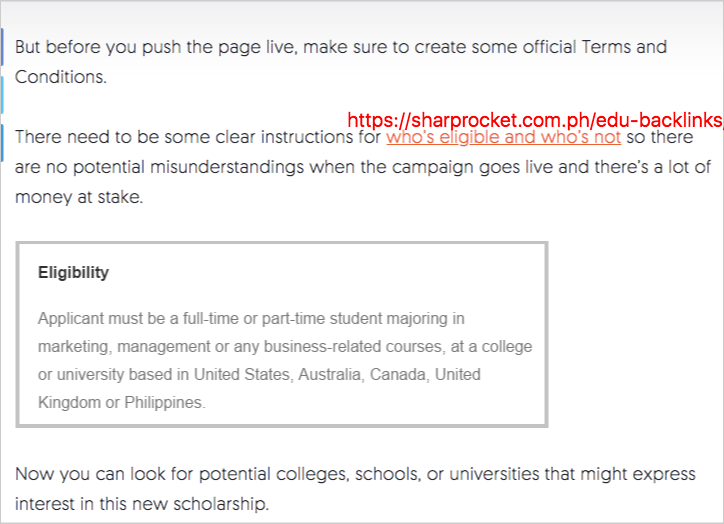
Editorial links are the most powerful type of links given that it signals Google that the brand being linked to is a trusted resource/reference (either it is targeting the homepage of the site or its inner pages/contents).
If a page from a website with good engagement and traffic references you with editorial links, it gives a signal of trust that your website is worth referencing. Of course, consider here the relevance and the surrounding text of the anchor text.
More and more, Google now understands the topic of a page based on entities — which will give you more emphasis on how they value your links from a relevance standpoint.
Anchor Text Distribution
It doesn't hurt to check the website's anchor text distribution.
You want to know if the site has a balance in its anchor texts for links.
Here is what the site's anchor text distribution should be composed of:
- Branded anchor texts (SharpRocket)
- Naked URL anchor texts (www.sharprocket.com.ph; https://sharprocket.com.ph/how-to-get-editorial-links-to-your-website/)
- Topical anchor texts (link building)
- Miscellaneous (click here; go here)
- Keyword-targeted anchor texts (editorial link building)
- Non-text links (image)
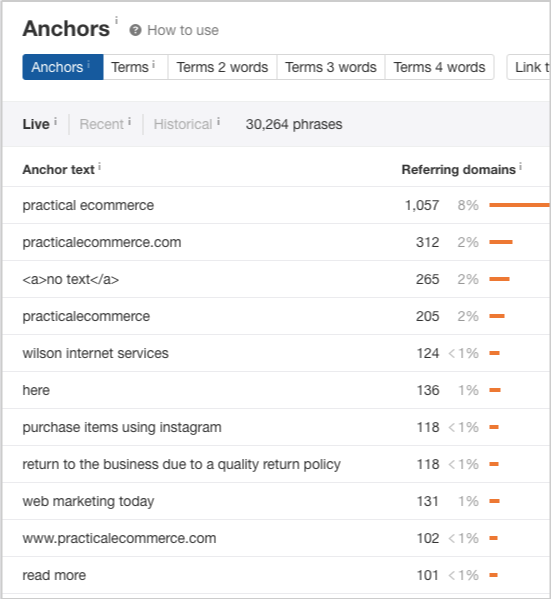
You only want to get a link from a website that isn't likely to get a penalty because of its improper balance in anchor text distribution.
Metrics
Another good determining factor if a link is good or bad is by checking third-party tools for metric calculation.
This means having a set of quantitative benchmarks to measure the authority of a prospect website.
Have a good grasp of viable benchmarks in your industry. The recommended number for Ahrefs DR is 20 and for Majestic TF/CF is greater than 0.75.
The website's contextual relevance, traffic, traffic location, link placement, anchor text distribution, and metric benchmarks (Ahrefs and Majestic) are good factors to consider when determining if a link is good or bad.
Google Link Penalties
It wouldn't hurt to know at least the basic overview or details about link penalties.
There are two Google link penalties: manual and algorithmic.
Basically, the difference between the two:
Manual link spam penalty happens when someone from Google's webspam team reviews your backlink profile, applies a google penalty, and sends you a notification in Google Search Console. The reasons behind this include a spam report from one of your competitors or there is something in your link profile that has triggered a manual review.
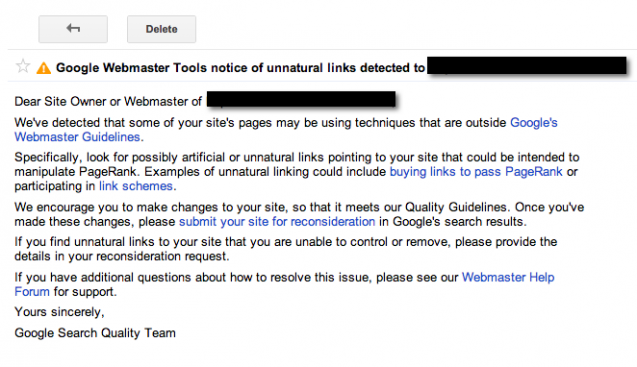
Meanwhile, algorithmic link spam penalty requires no human review but is automatically applied by Google to your site based on your site's backlink profile.
Both of these penalties can lead to a significant drop in organic traffic. So, it's a must to monitor your website on a daily basis.
Type 2: Algorithmic Link Spam Penalty (generally Penguin)
An algorithmic penalty is a penalty that is applied automatically by Google based on your link profile. No human review is required.
Less Effective Link Building Tactics
There are many link building tactics that you can use today. Some are white-hat, grey hat, or black-hat.
Whatever the color is, there is one thing you have to identify - the effectiveness of the inbound links to your site.
This is where the high-performing link building professionals differ from the average ones. They know what specific techniques can move the needle of results — organic traffic, additional authority to the page/site, so on and so forth.
The days are gone when you can shortcut your way to ranking success.
Here are some link building tactics that are totally obsolete, some of which are ineffective when not properly scaled.
Discussion Spamming
Community websites and other platforms where people would have a chance to discuss relevant topics and are allowed to input links to reference some points that have been spammed for many years.
Blogs that allow do-follow comments have been all-day submitted for comments with exact match anchor text links.
"This is a superb post", "Your article is good", or any fluffy, no-value blog comments won't make the cut.
Alternatives to discussion spamming
1. Target discussion pages with high traffic
Discover discussion pages with recurring traffic. These are Quora discussions and niche forum threads are continuously getting visitors because the topic is focused on audience needs.
Here is a good example in Quora for anyone tapping the giant sleeping industry.
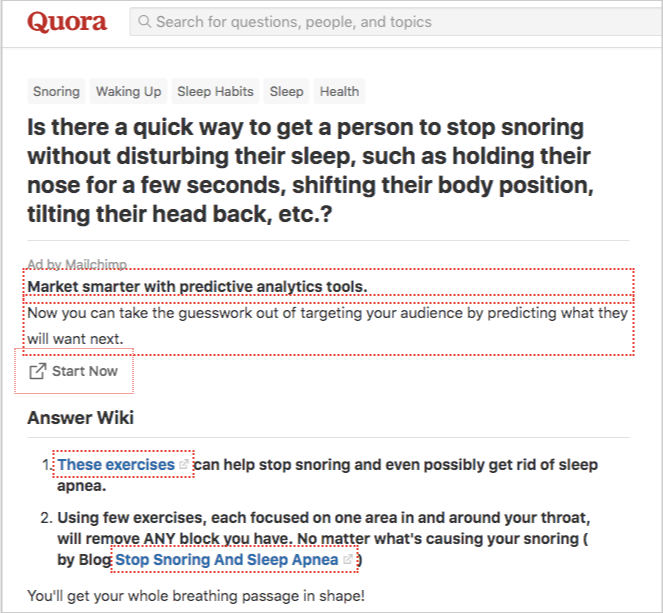
To discover these pages, you can use Ahrefs and enter the domain URL of Quora or other community discussion sites you'd like to reverse engineer with.

Go to Organic Keywords and search for topics in your industry.
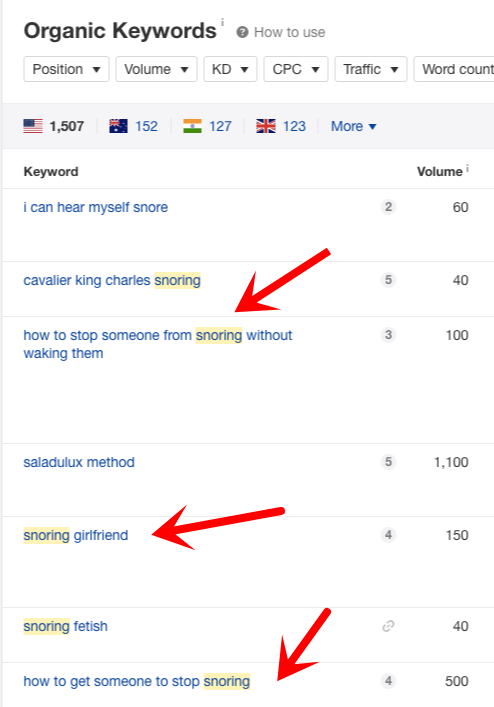
Go deeper with the results. Filter keywords based on position (0-10) to only get Quora pages that are ranking on the first page of search results and set search volume to greater than 100. This assures you that the Quora page gets a considerable amount of organic traffic.
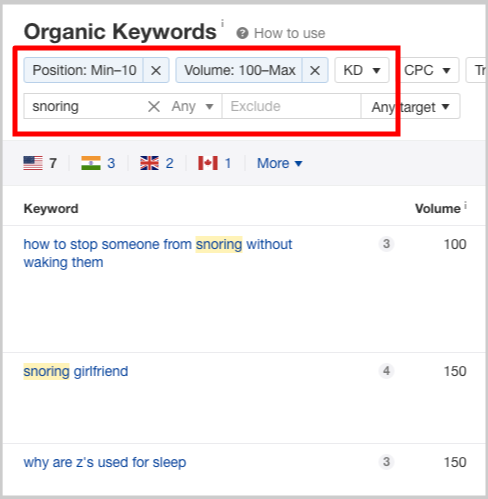
Go over to Quora pages that you found to be relevant to your site and where you can participate strategically based on your expertise. Don't just insert bad links if it's not relevant to the discussion.
2. Focus on 3 to 5 industry blogs to comment on.
The reason why marketers spam industry blogs are that they're too much focused on quantity over quality link. Inserting blog comment links to a hundred sites doesn't mean you're getting the results that you want.
To battle that, you can simply focus on 3 to 5 top-notch blogs in your industry.
Of course, you have to check if those blogs are accepting blog comments, regardless of whether they allow do-follow links (or by default no-follow).
Spend a good amount of time thinking of what would make the discussion better by scanning and reading the entire content. If it takes only a few minutes to read the whole article, do so, so you can craft a better quality site comment.
Submission Techniques
Getting links from websites that allow listings for business sites like directories can help diversify your backlink profile — making it as natural as possible.
However, doing so without carefully checking what makes the submission worthy of investment from a link perspective is a serious matter.
There are many low-quality directories, even generic submission sites that are already losing much traffic.
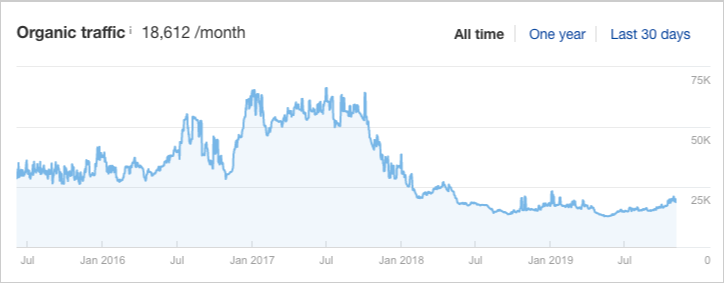
Of course, those sites are good to submit your website to, to acquire some links initially. However, putting much effort into this less effective link building technique should be thought of carefully.
Alternatives to generic submissions
- Find local citation directories in your city/state. If there are niche-specific, go over and prioritize submitting website details to them.
- Discover non-profit organizations where your business has been part of. Reach out to website managers and ask to be included in their profiles.
Improper Scaling Techniques
One consideration when scaling any link building technique is the person executing it maintains and improves the quality of activities.
In guest blogging, for example, link builders pitch the target guest publishers with the same generic pitch they've seen on SEO blogs.
This decreases the value of what they do as the campaign itself isn't focused on the unique proposition of the pitch.
Another example is when link roundups became popular from 2012 to 2015. A lot of marketers both in the internet marketing industry and other verticals started to pitch experts, practitioners, and top bloggers and publishers to get just "one tip" from each of them.
This was all for the purpose of compiling these tips in one roundup post and calling it "great content".
If you know how to use HARO and monitor HARO requests for your brand, you may have seen publishers looking for expert tips in HARO itself. They turn the platform into an ego bait ecosystem where they can easily request short-form content.
The problem with scaling link building techniques that sacrifice quality is that the value that should be given to its end-users diminishes as those exact techniques are aggressively used by anyone.
Alternatives to low-quality scalable link acquisition techniques
1. Use content gaps as topic ideas for guest blogging
Find content gaps in your target publisher's blogs. Look for keywords they haven't ranked yet but their competitors have.
You can use Ahrefs to find what they are currently lacking in content based on what keywords they are not ranking yet.

List those insights in your guest blogging spreadsheet.
When you start pitching publishers, you include in your email copy the list of suggested topic titles that correspond to potential keywords that they can target.
This simple tweak to the guest blogging process can make a great difference in how the response and conversion rate would turn out.
Emphasize the value of potential ranking opportunities from your enlisted topic ideas.
2. Use pre-link bait strategy to check topic's linkability
Producing long-form link bait content assets is risky particularly in today's time where you don't know whether your audience would share or even link to your content piece.
One way to check the linkability of your content is to actually start a preliminary outreach campaign.
The idea is to know whether your topic or a list of X websites content has chances of acquiring the links.
You send emails to publishers, influencers, and top-notch bloggers with the intent of asking them to be included in your linkbait content. Who would reject the idea and don't want to be featured?
Without them doing anything, you already give them enough value beforehand.
Once the content is published, you share it both with people who responded to your initial pitch and to people who might also be interested to share or even linking to your ego bait.
Seek For High-Quality Backlinks
Spammy links are everywhere. It's up to you and to me to analyze which opportunity from a page or site is worth asking for a link, and/or is worth trying to send an email pitch.
Seek editorial links from relevant websites that get monthly traffic from search (through ranking for its targeted keywords). Improve the same old link building strategies but with a new and improved version of unique propositions to ensure you're getting the most out of your link building efforts.




